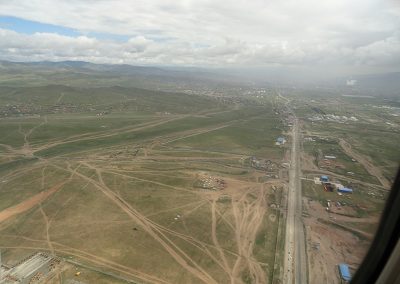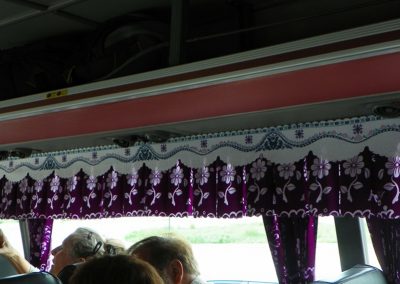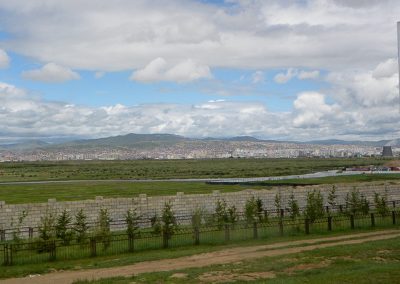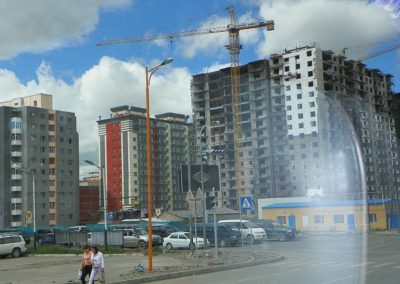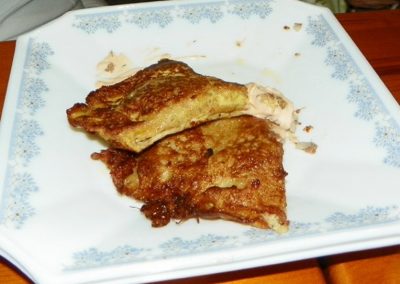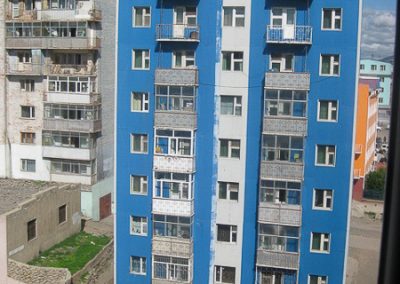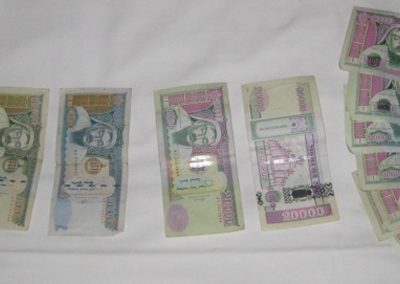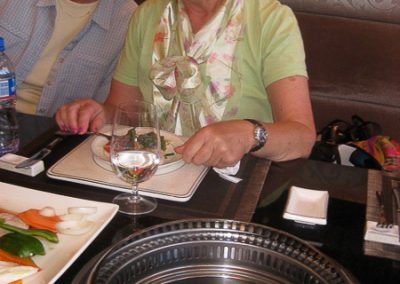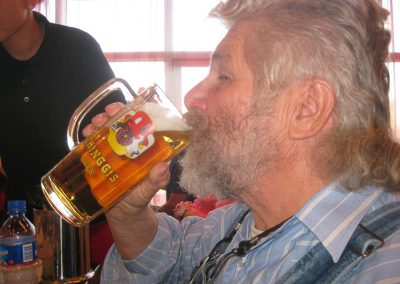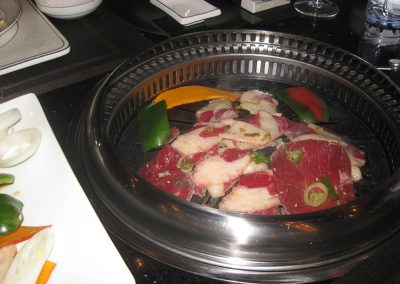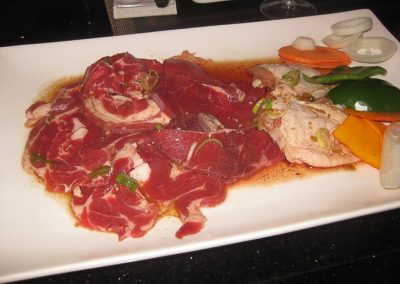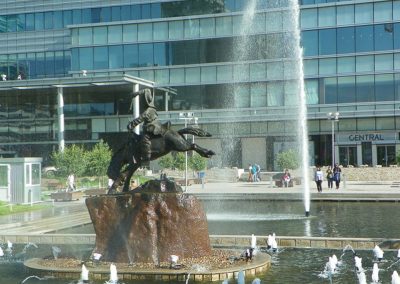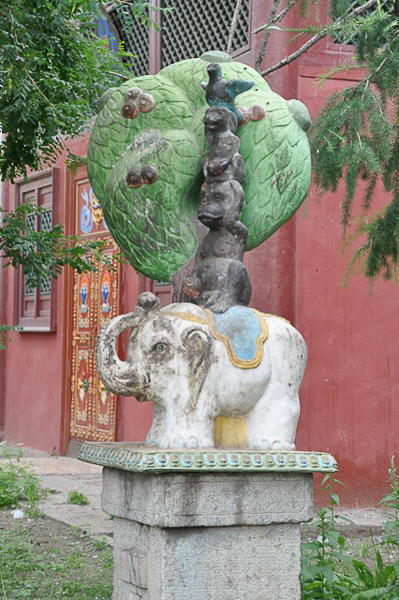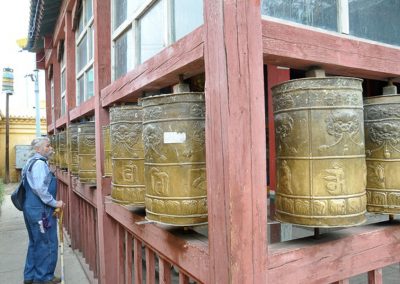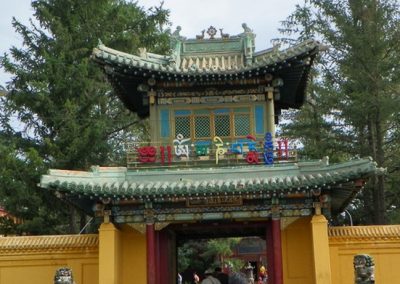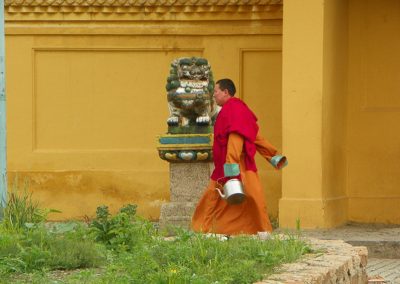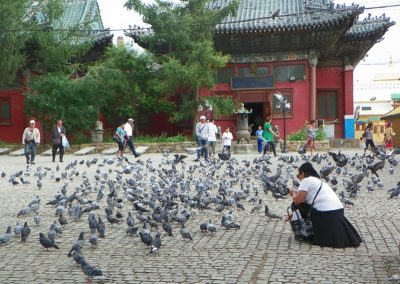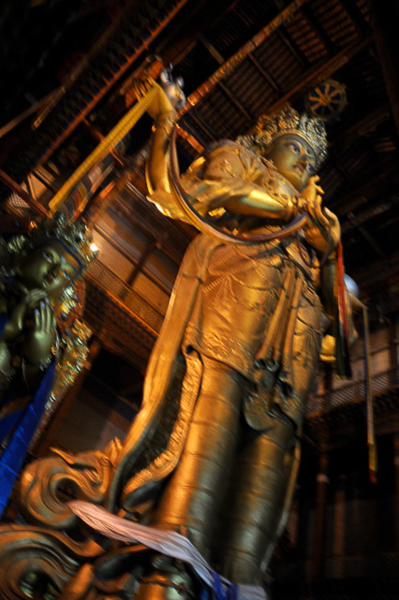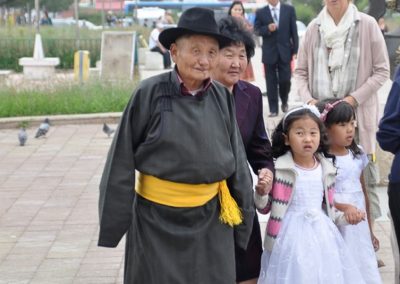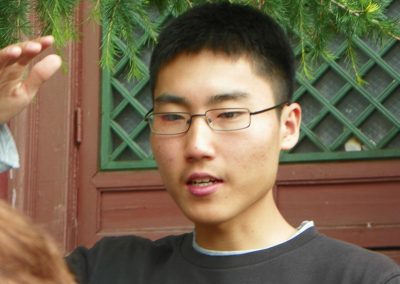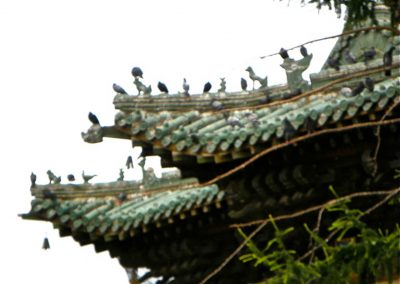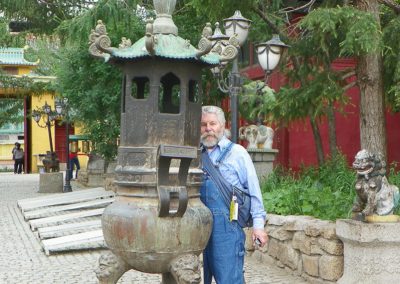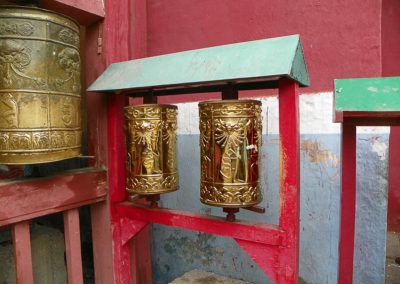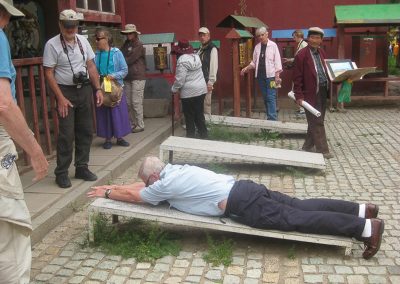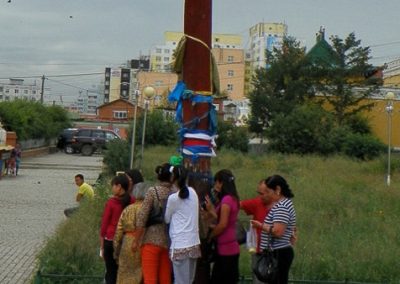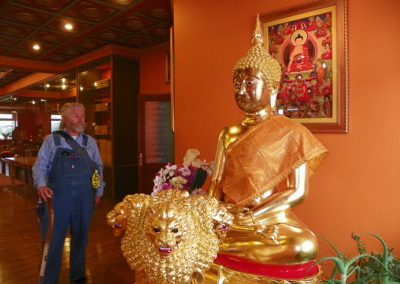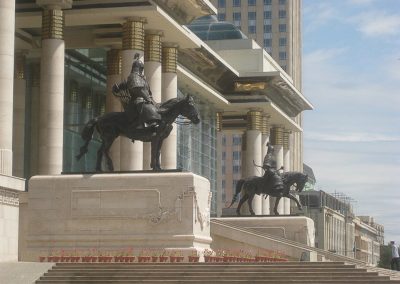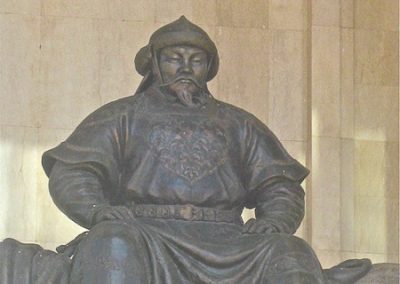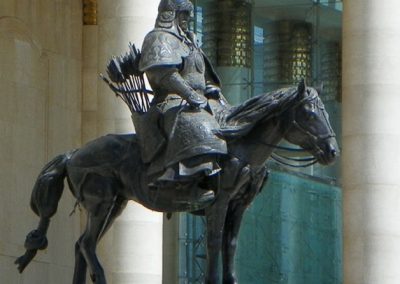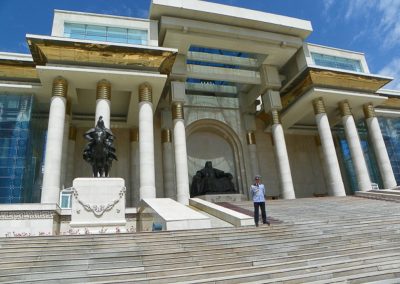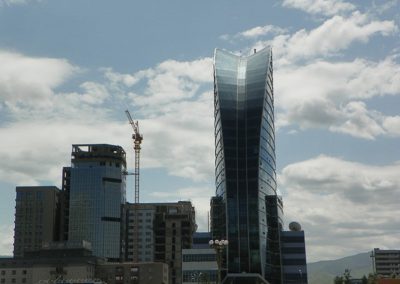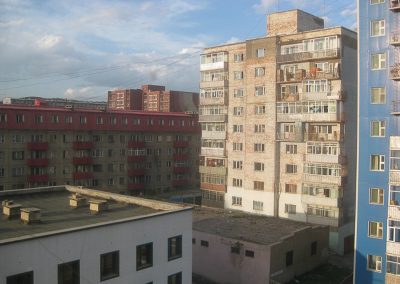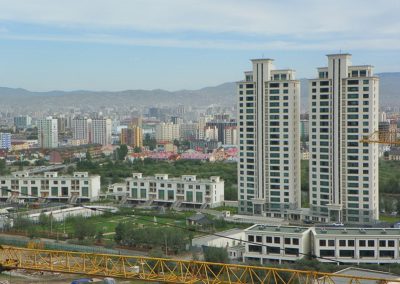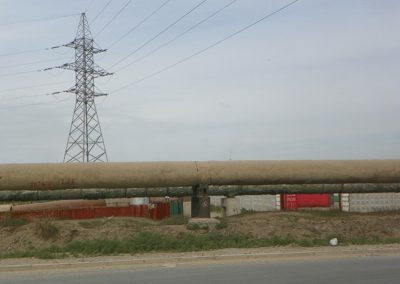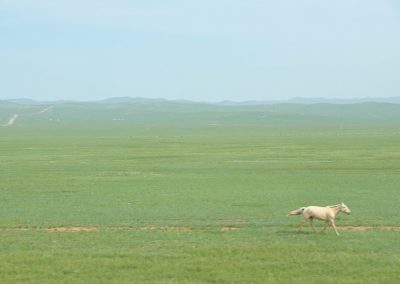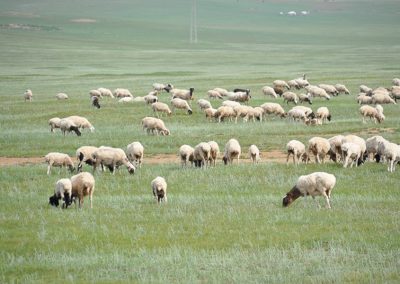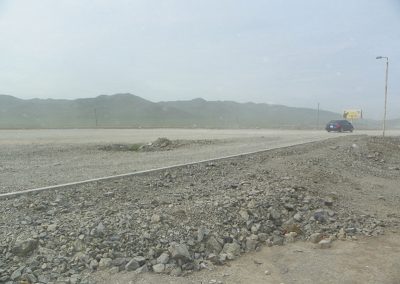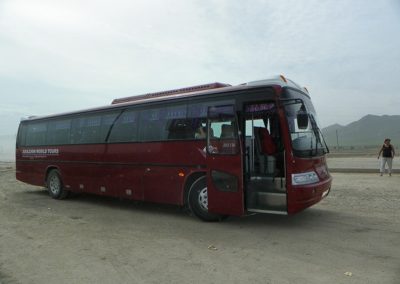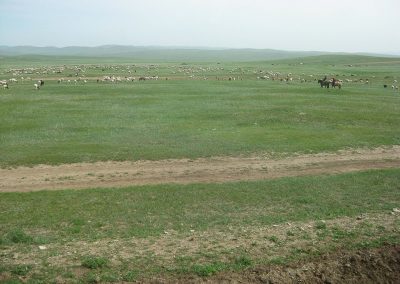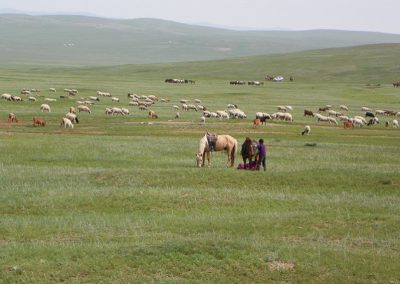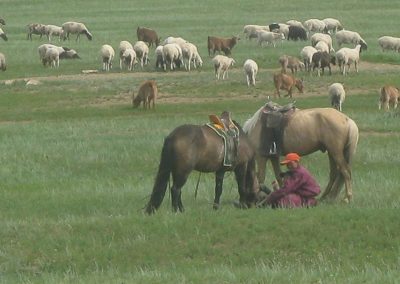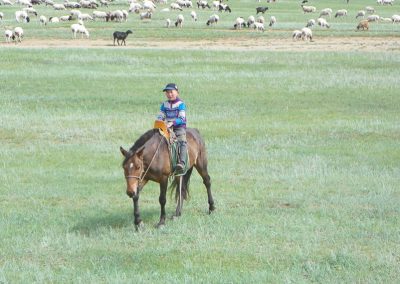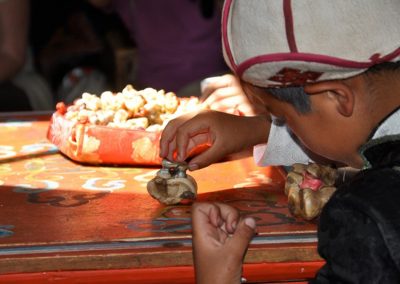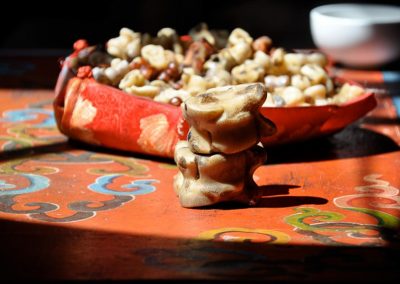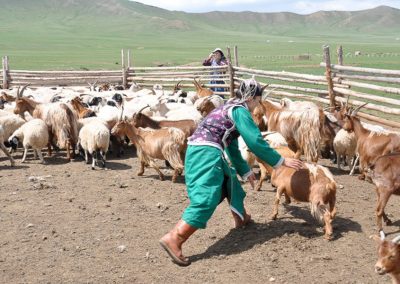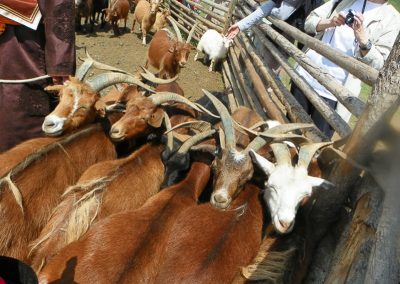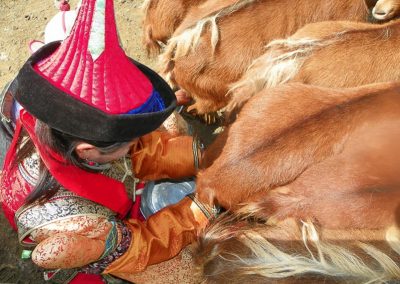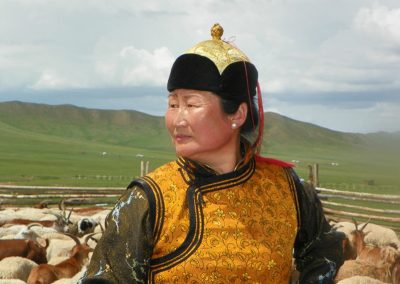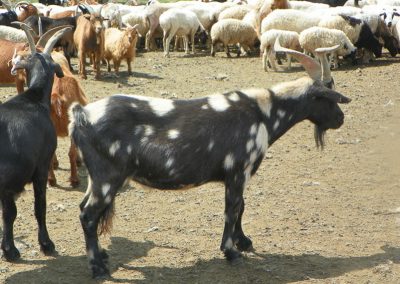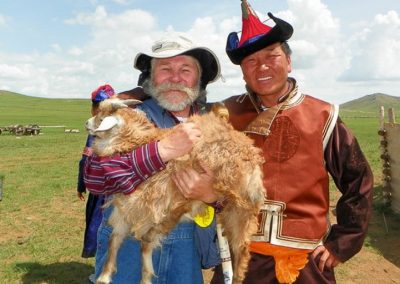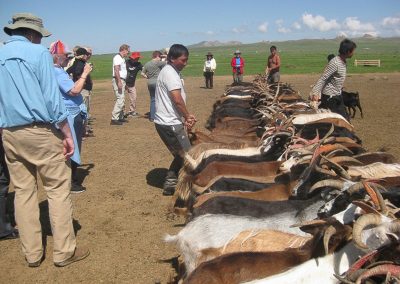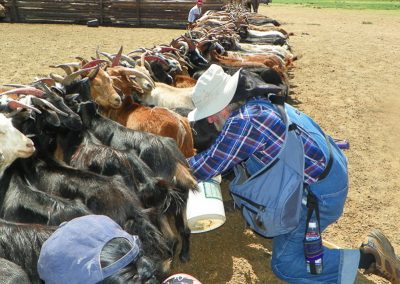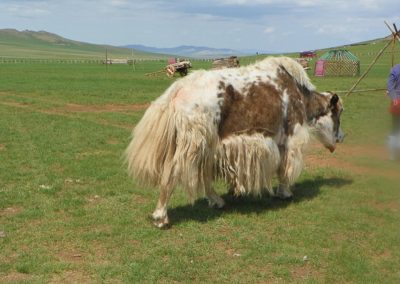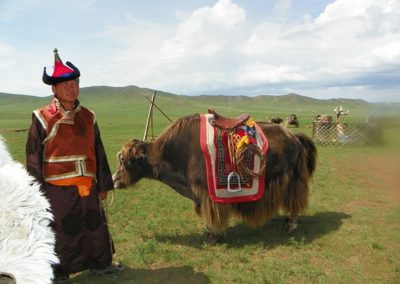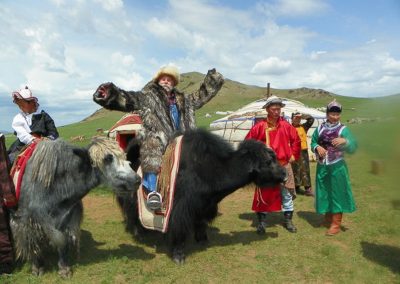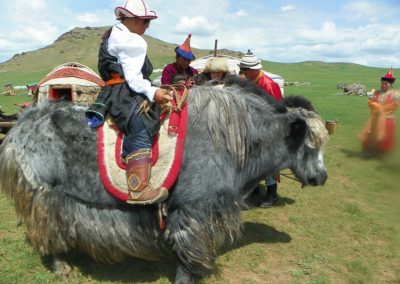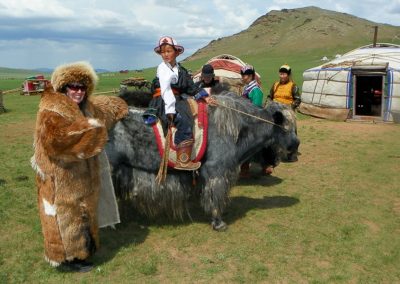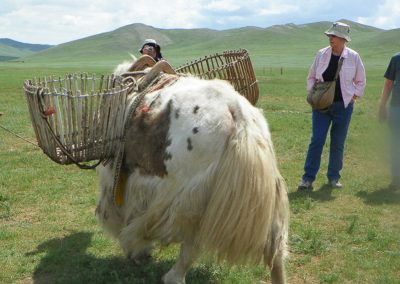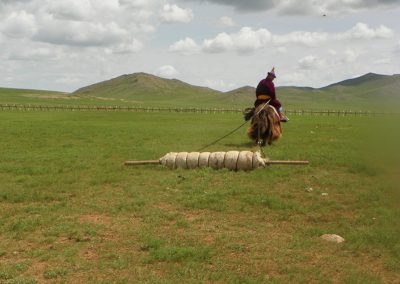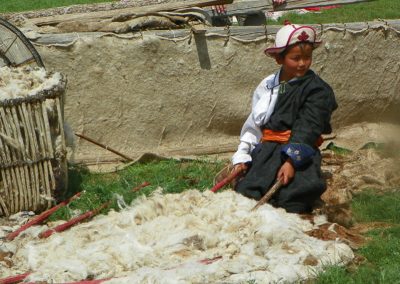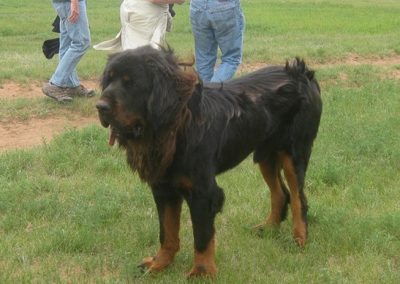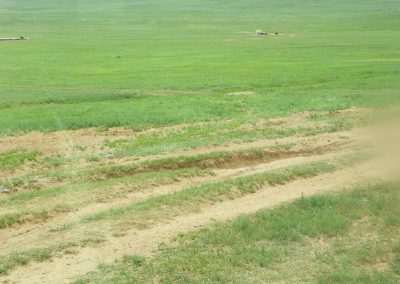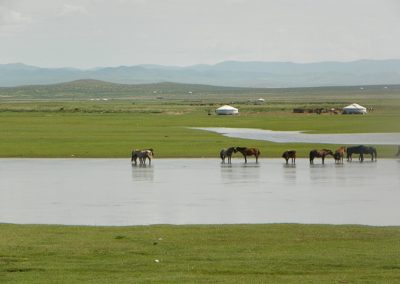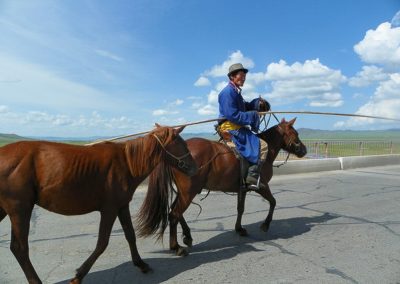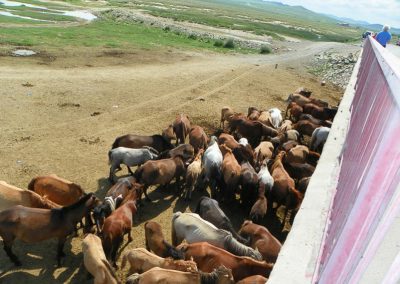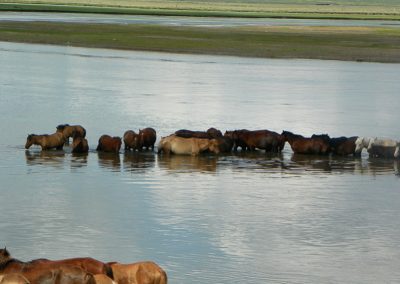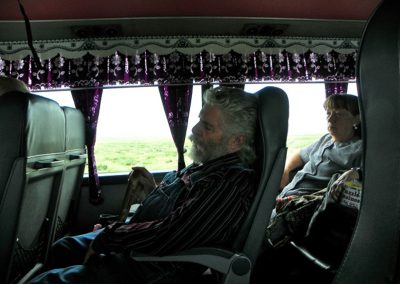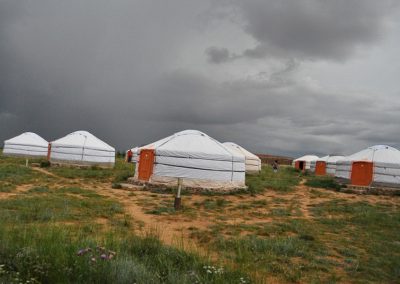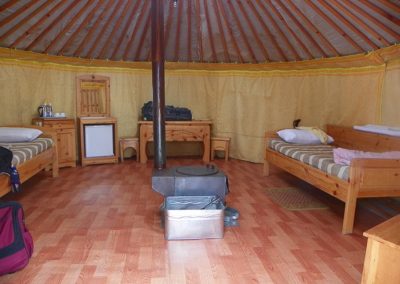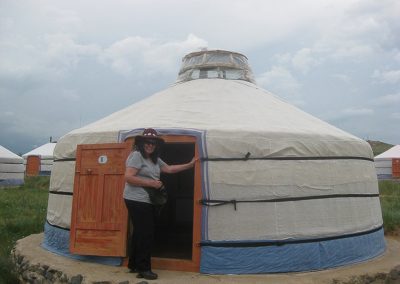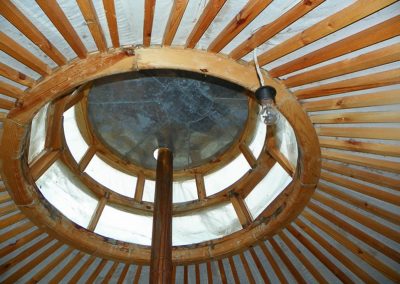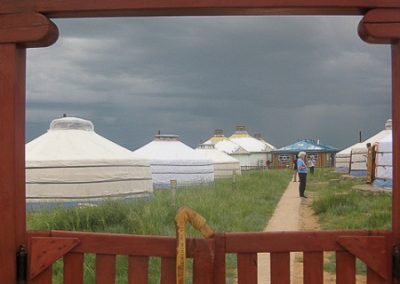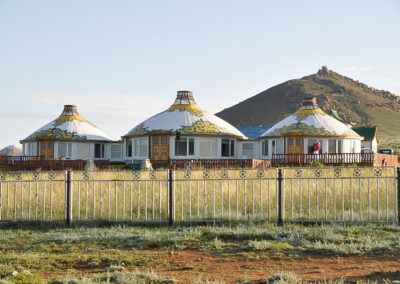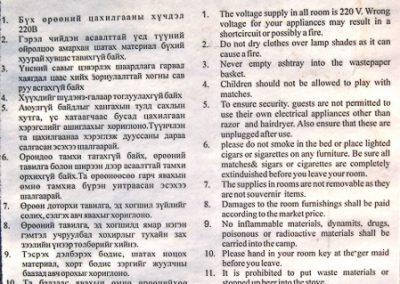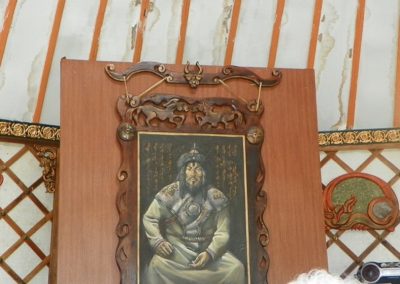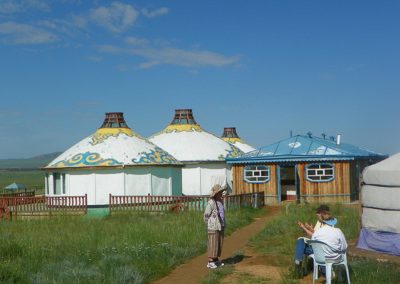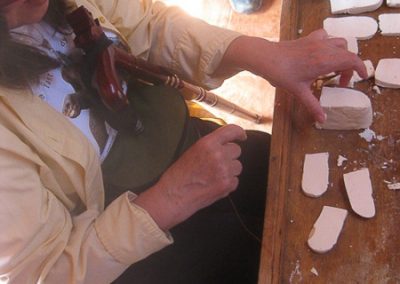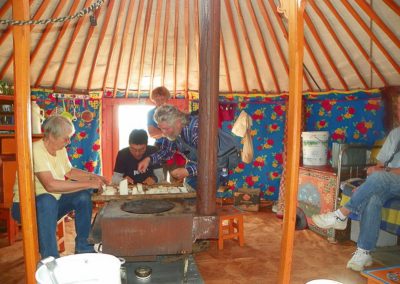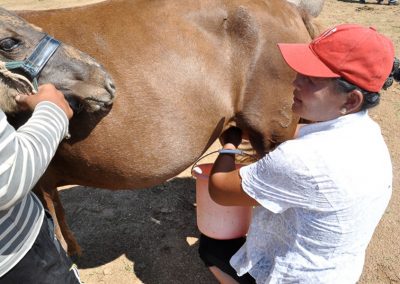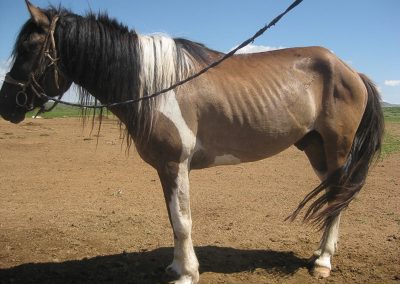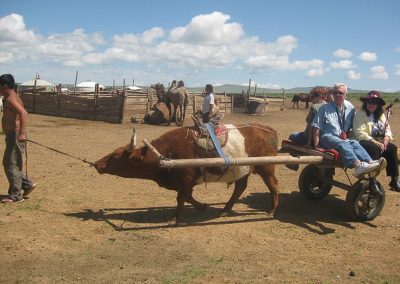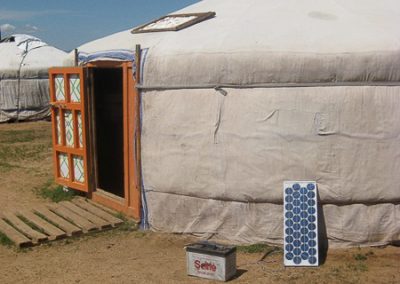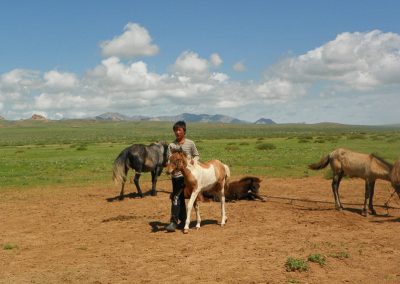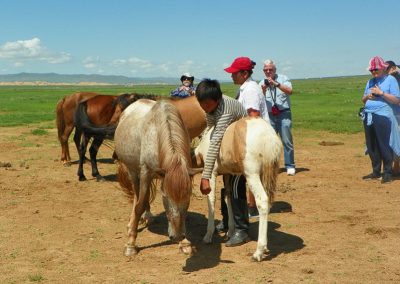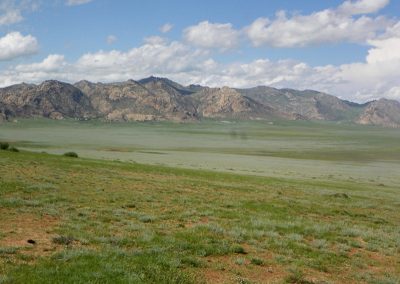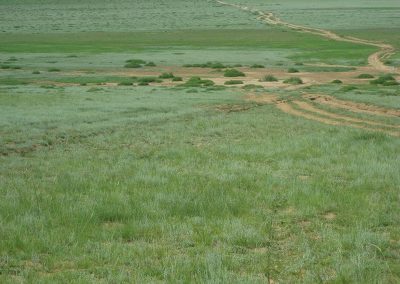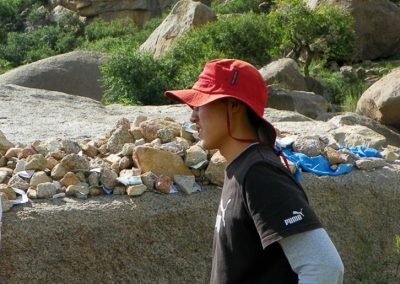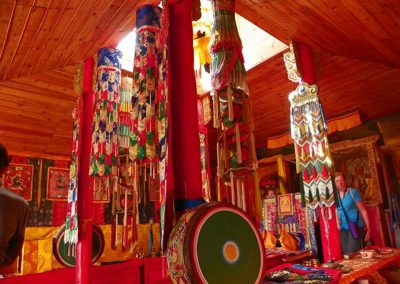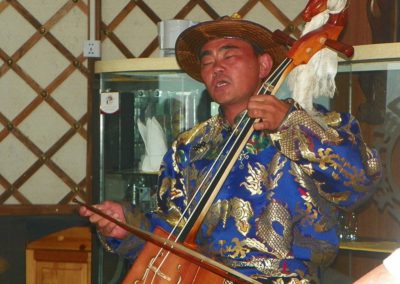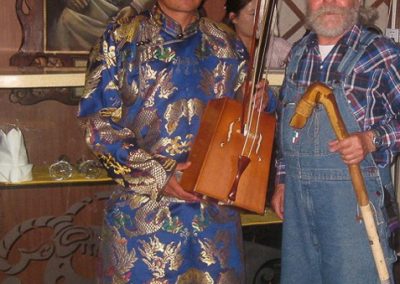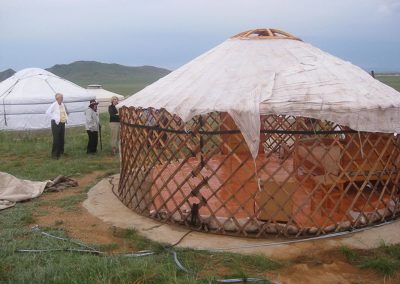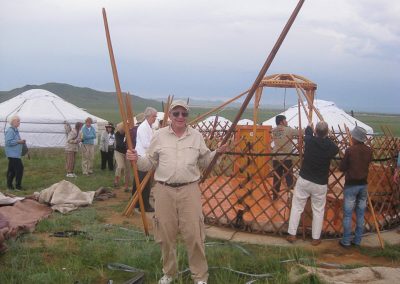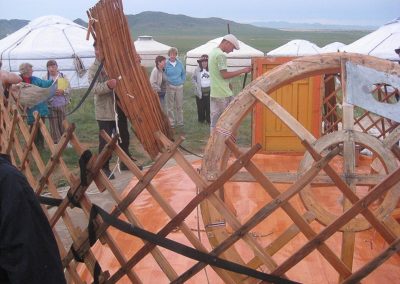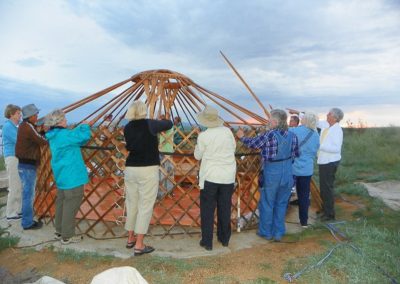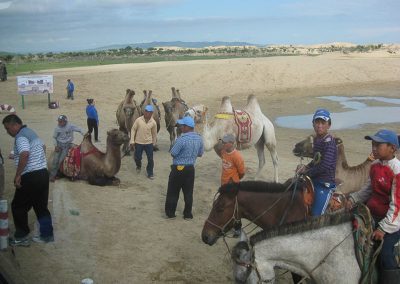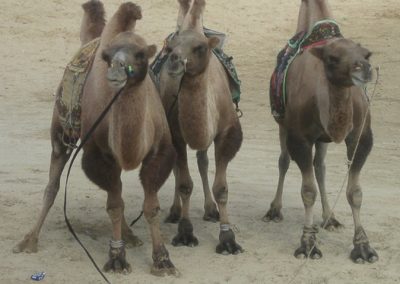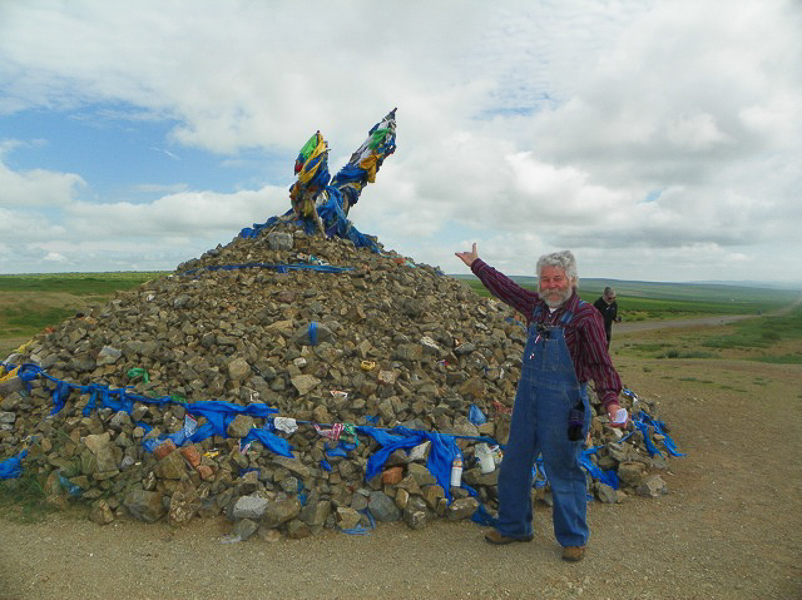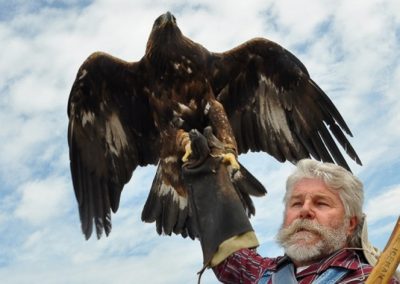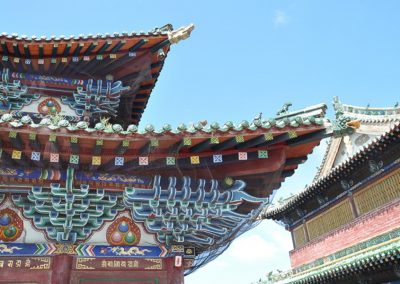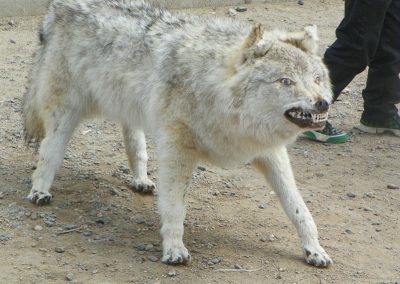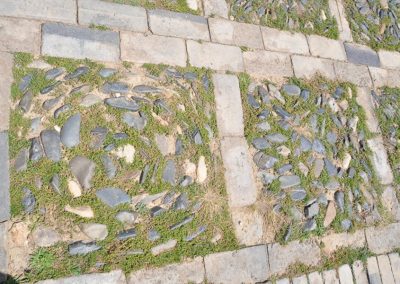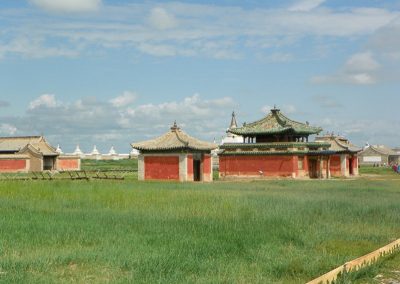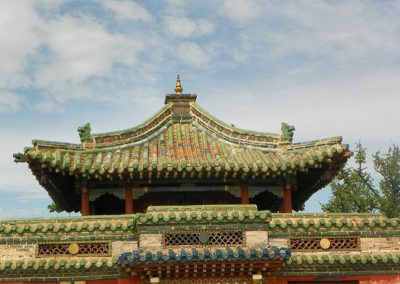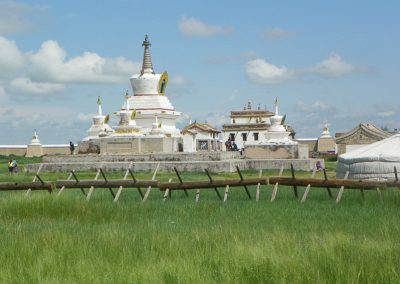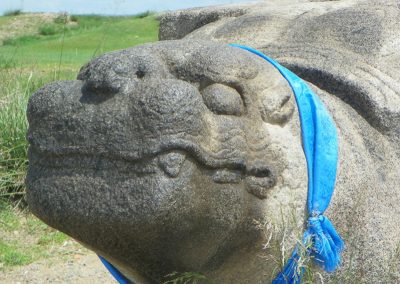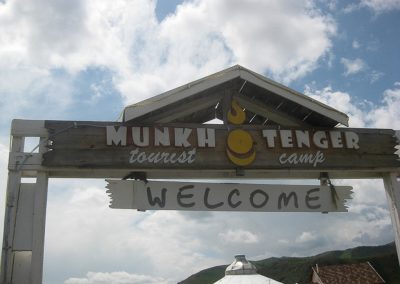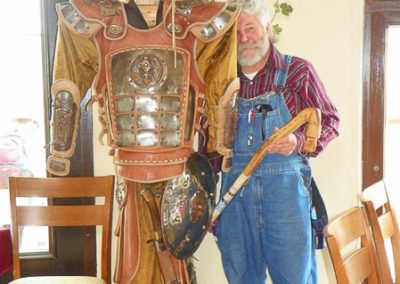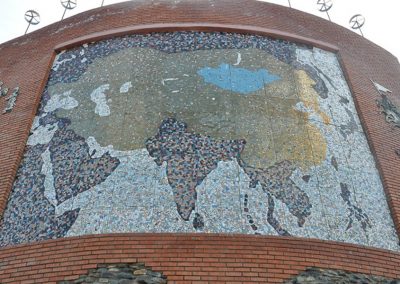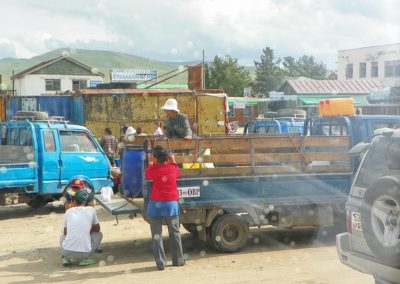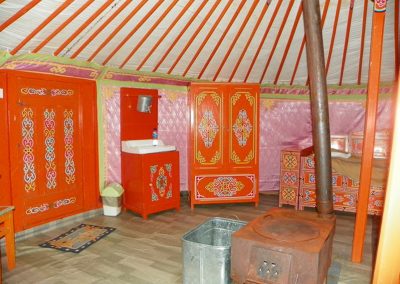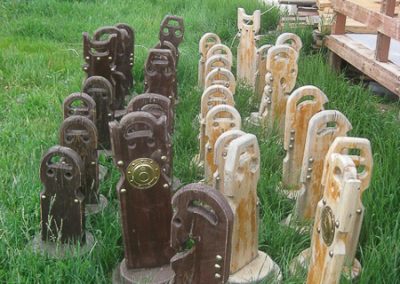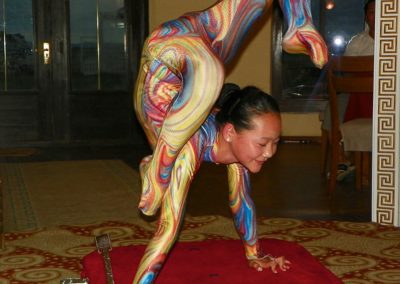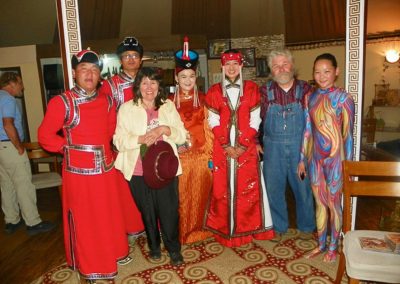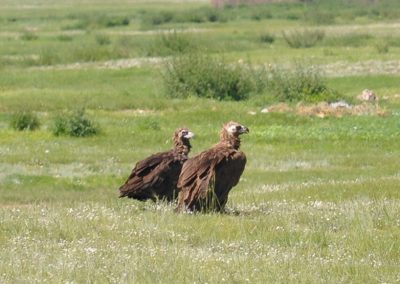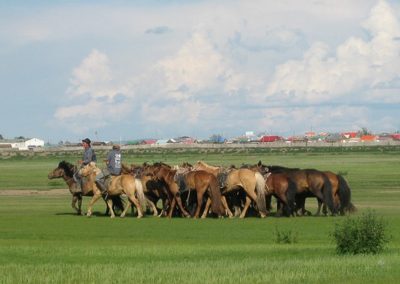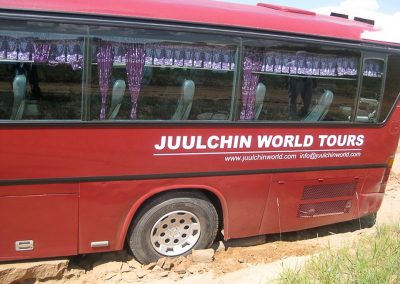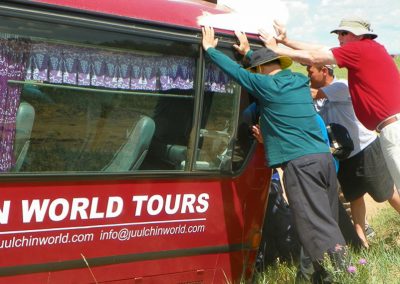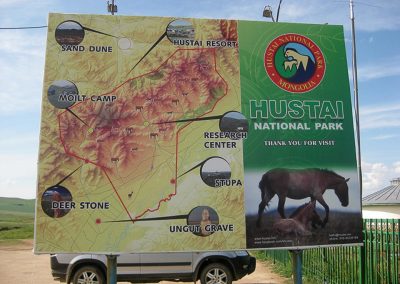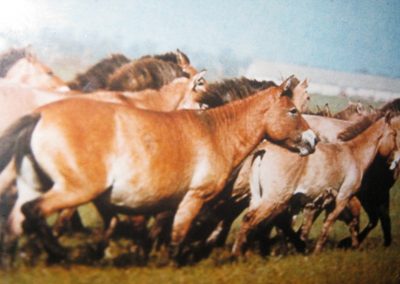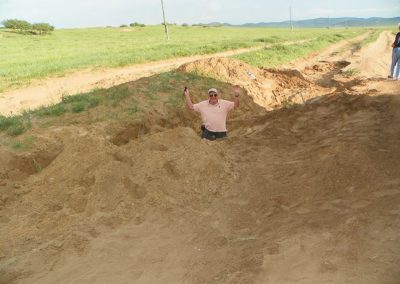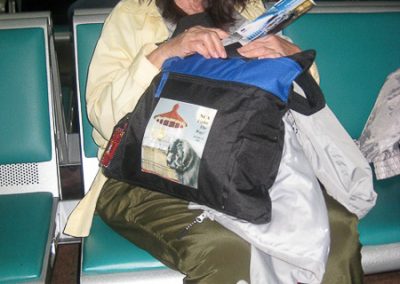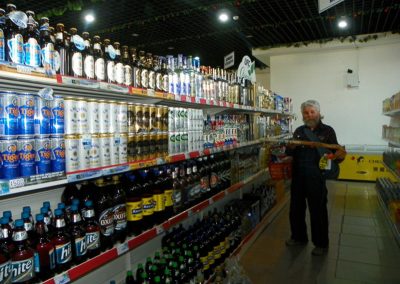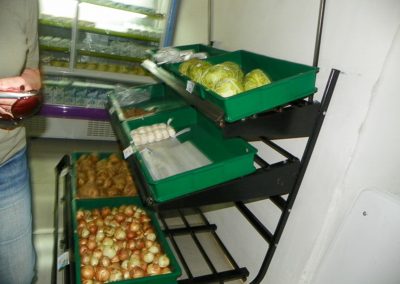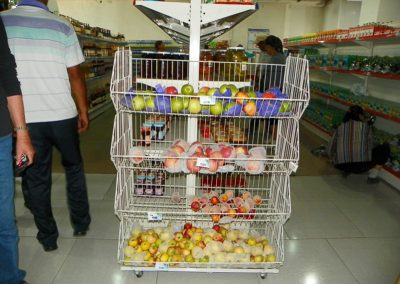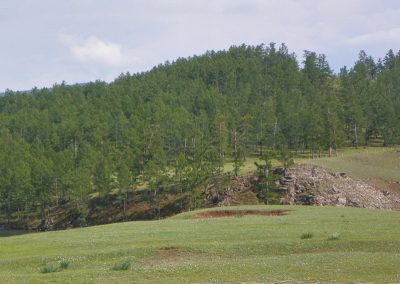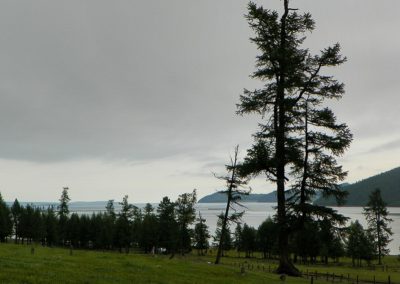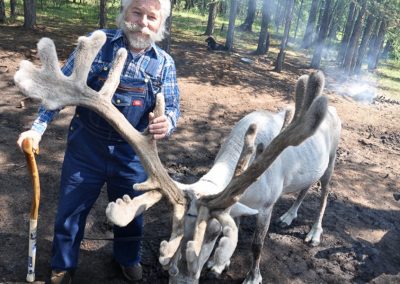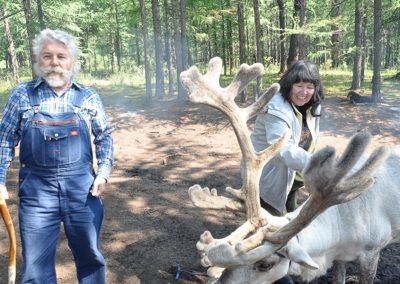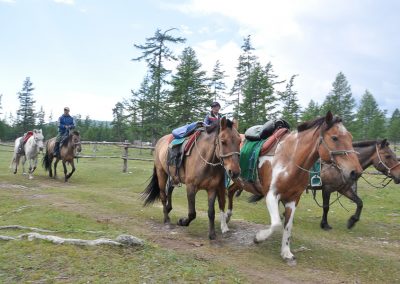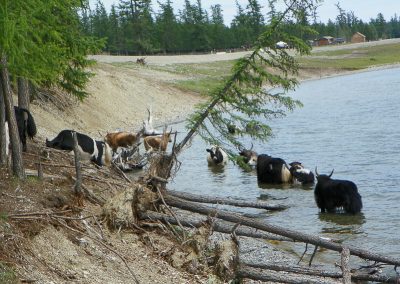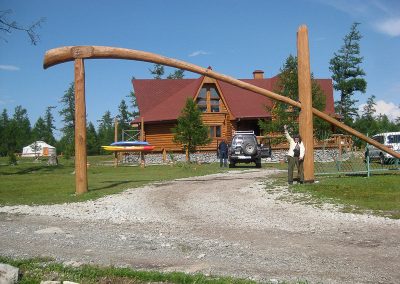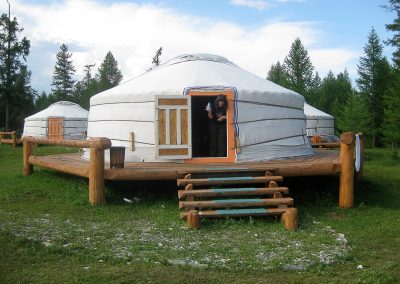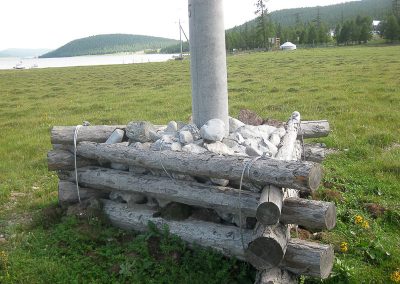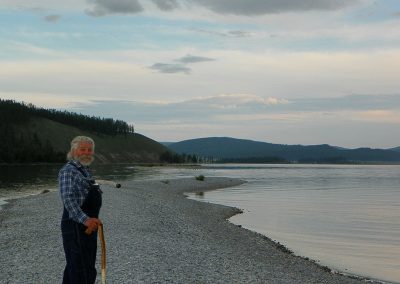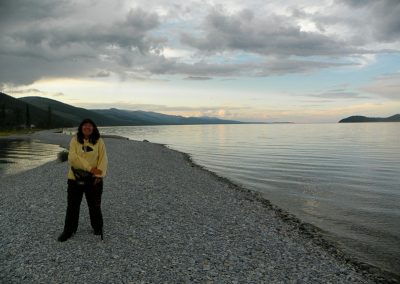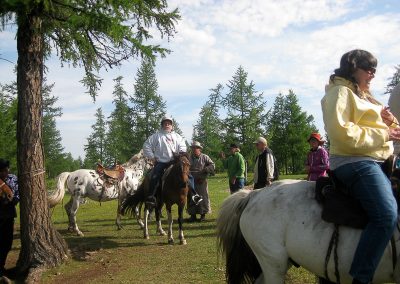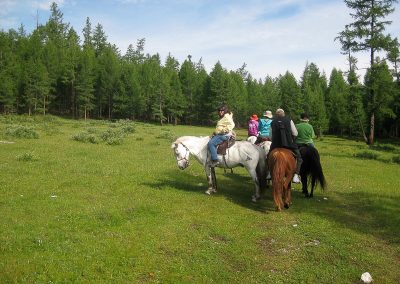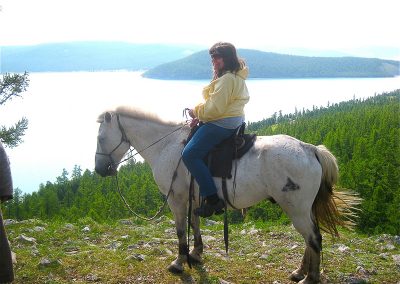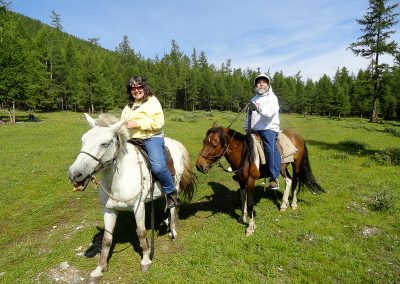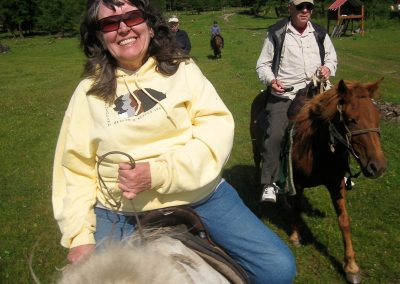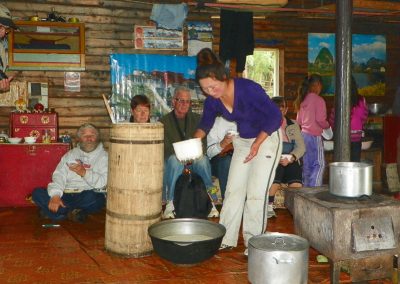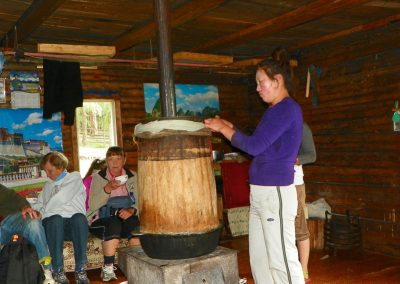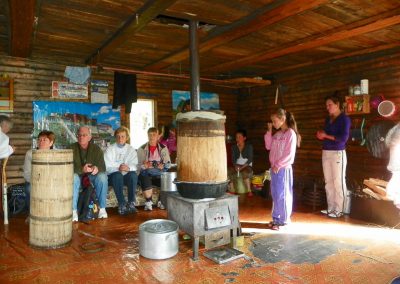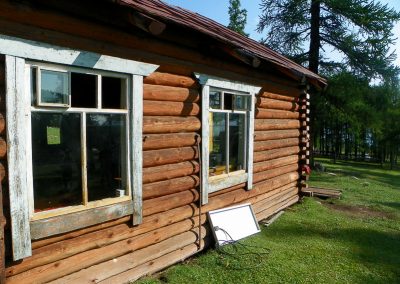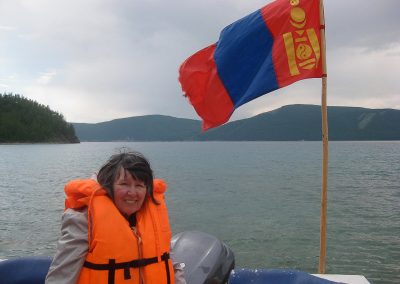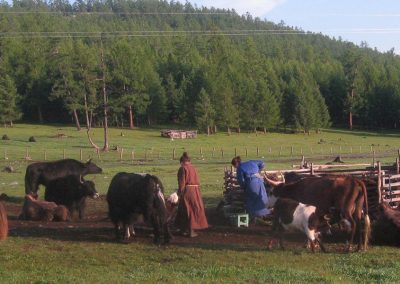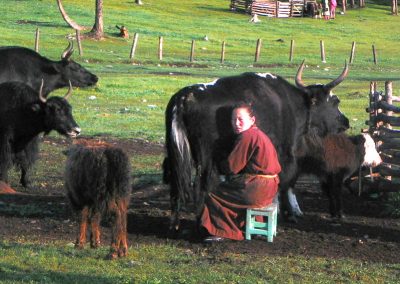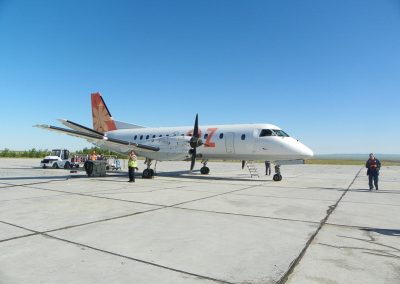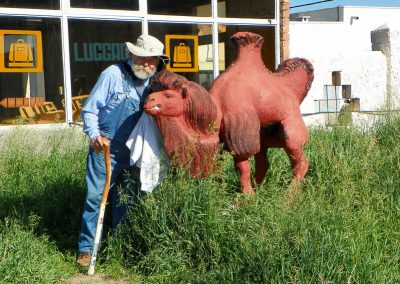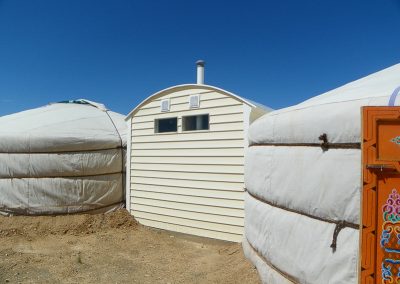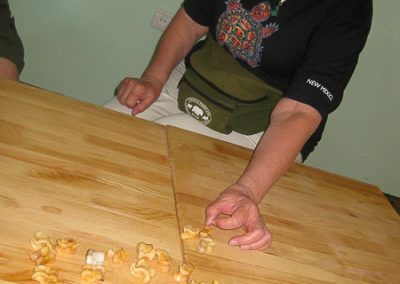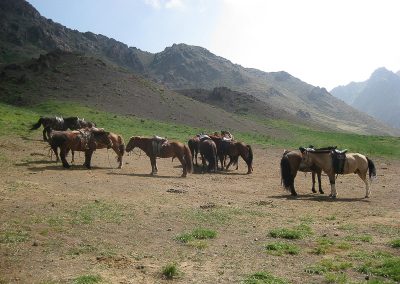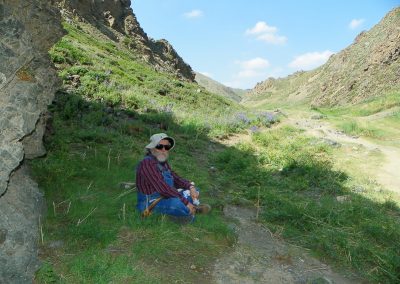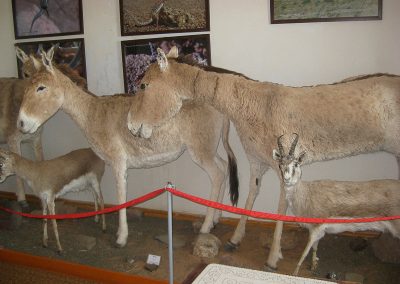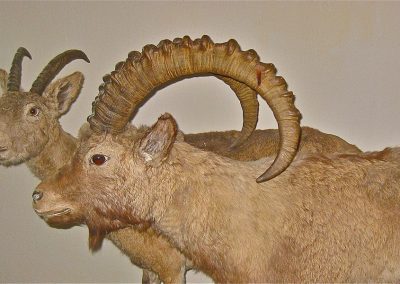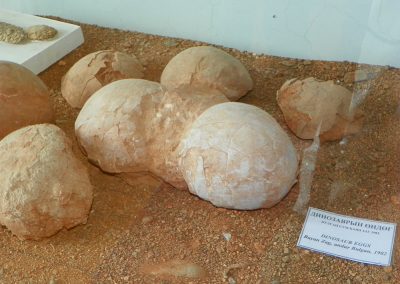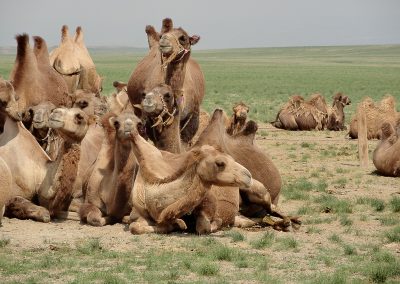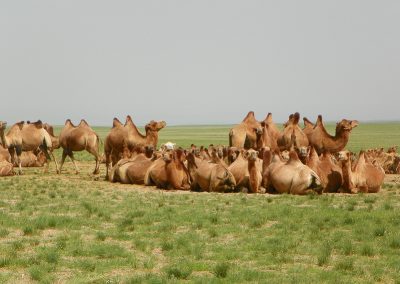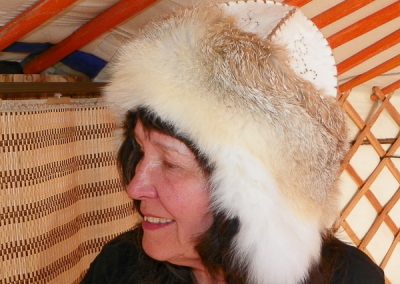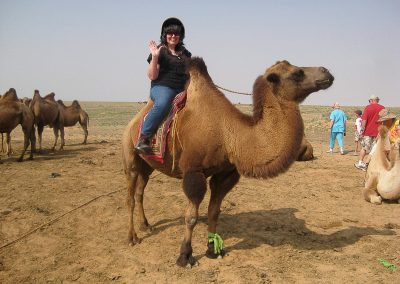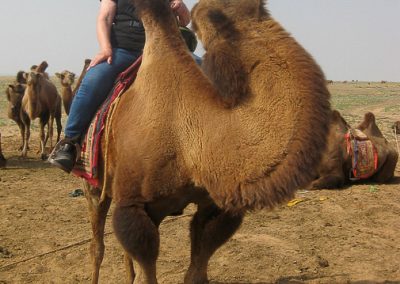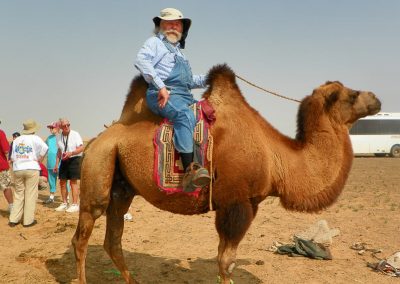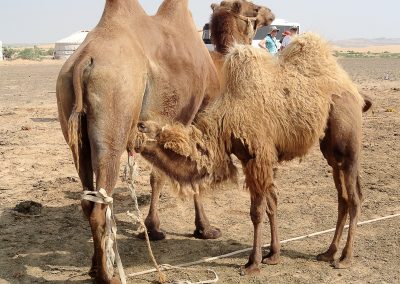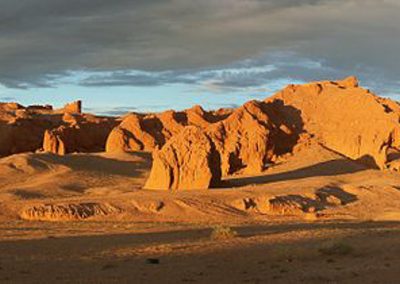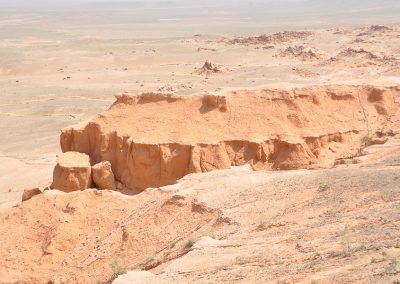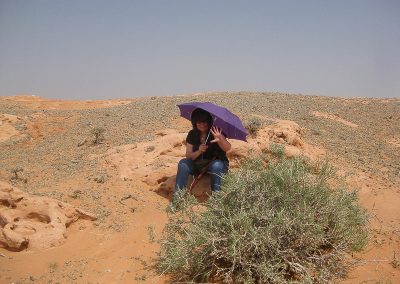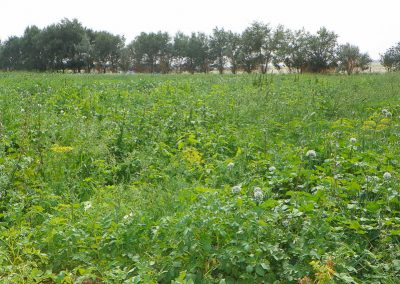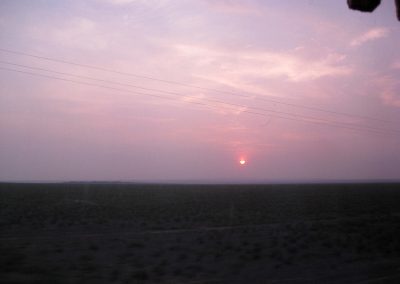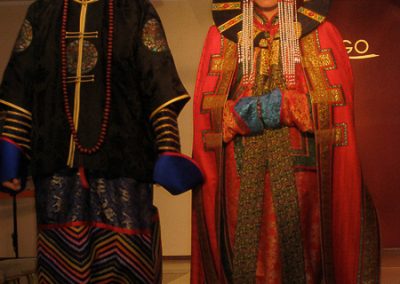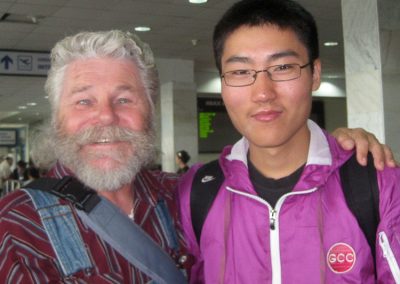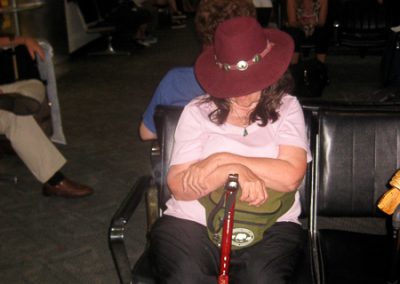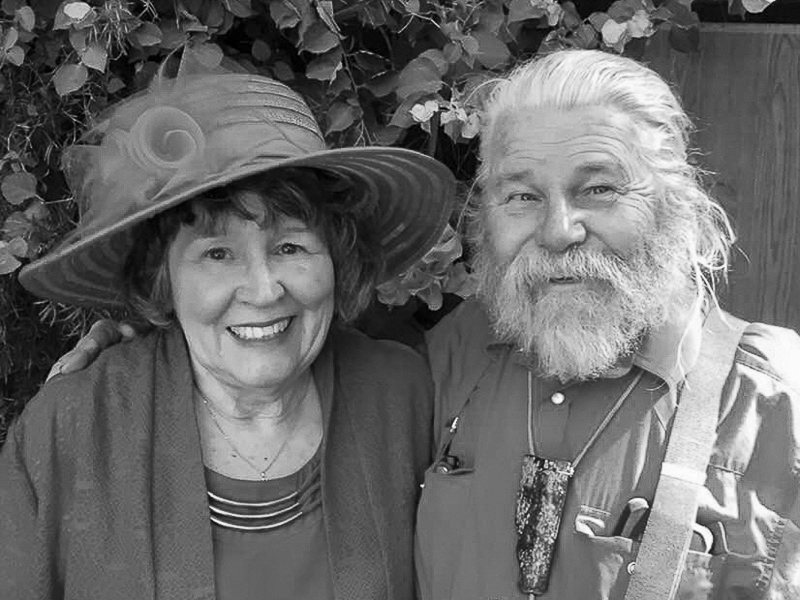
Mongolia – 2012
Welcome to Mongolia
As we left Beijing it was too cloudy to see the Great Wall of China from the plane. We flew north and a bit west to Ulaanbaatar, the capital of Mongolia. Ulaanbaatar, meaning Red Hero, sits on the Tuul River, 4,300′ above sea level and home to over a million people. It is often shortened to UB, with the local newspaper the UB Post. This photo on our decent into UB shows all the jeep roads over the plains. There are very few paved roads in the country, most are in UB. Occasionally our bus found a section of pavement, but this was rare outside the UB area.
Mongolia – Welcome 01
Flying into UB was gorgeous. Must have rained recently as the steppes and rolling hills were green. The city sits in a bowl, so air inversion/pollution is a problem. I expected the airport to reflect the million population, it didn’t. In fact it wasn’t much larger than the one here in Santa Fe. It was a cool 65 F degrees, perfect to me! And it was dry compared to hot and muggy Beijing.
Mongolia – Welcome 02
We gathered up our luggage and went out to find Billy, our guide. His real name is Bilguun-Ochir and that’s his first name, thus Billy to us. He’s 19, spent 5 years ages 12-17 in UK, now planning a diplomatic career after college. I was afraid that he’d take off at a fast walk at the airport like our speed walker guide Penny at the Beijing airport, but much to my delight he walked slowly and stopped frequently for us to catch up. Before leaving the airport we went up to the second floor to the Capital Bank office to exchange US dollars for Tugrugs, pronounced toogroos. I think the last g gets dropped. The exchange rate is $1 US = 1,344 Tugrugs. Therefore, our exchange for $150 resulted in huge denominations of Tugrug bills. Leaving the airport we found the bus to be a Mercedes-Benz and decorated by my mother with purple flowered curtains. OK, not my mother, but someone with similar taste.
Mongolia – Welcome 04
Much of UB was constructed during the communist era, and resembles concrete housing projects in Chicago. The style persists to this day.
Mongolia – Welcome 05
First stop was for lunch, a restaurant specializing in both Russian and Mongolian food. First came a large bowl of beef and barley soup, followed by potato pancakes stuffed with beef. It was delicious.
Mongolia – Welcome 06
Our home base for whenever we were in UB was the Kampinski Hotel. It was luxurious. The photo below was the view from our window, the typical UB apartments.
Mongolian Beef
After the orientation meeting we took a walk near the hotel, ending up at a local grocery store. It was a strange combination of English, Russian and Mongolian labels. Not much in the realm of fruit and vegetables compared with Chinese markets, however the alcohol section was twice the size of fresh fruits/veggies.
Took the bus to the Buffalo Restaurant for dinner, Mongolian Beef cooked over charcoal at each table by a young Mongol woman.
Mongolia – Beef – 03
The raw food before cooking. We also noticed that even the best restaurants offered toothpicks at the tables.
Mongolia – Beef – 04
The beef was tough, really had to chew it. Some vegetables, peanuts, rice and potatoes, with ice cream for dessert.
Gandan Buddhist Monastery
When the communist Russian influence hit Mongolia in 1921 many of the Buddhist Temples were closed or destroyed. In one case an enormous 22m Buddha was hauled off to Russia, melted down and made into bullets. The replacement Buddha now stands in a tall building. The Buddha is one of protection and looms large over the city to offer security.
Mongolia – Gandan Buddhist Monastery – 01
The totems in this photo are a bird sitting on a rabbit, sitting on a monkey, sitting on an elephant. I can’t remember the significance of the large green fruit-like object behind it.
Mongolia – Gandan Buddhist Monastery – 02
The grounds of the Monastery are extensive with many sections of prayer wheels like this.
Mongolia – Gandan Buddhist Monastery – 03
The entry gate into the courtyard. The script on the roof is in the traditional Mongolian. Under the Soviet influence they changed their script to Cryillic.
Mongolia – Gandan Buddhist Monastery – 04
The monks range in age from small boys to older men. This one is carrying a tea pot. Tea was often served to those chanting and worshipping.
Mongolia – Gandan Buddhist Monastery – 06
The large Buddha. I’m not sure if it was solid metal or only a coating.
Yellow Sect Buddhism
Mongolia – Yellow Sect Buddhism – 01
This is our guide Billy, His real name is Bilguun-Ochir Erdenebat. He is 19. The Mongolians are Yellow Sect Buddhists, closely related to Tibetian Buddhists. It’s a rather liberal sect as in monks can marry, have cars, etc. The Gelug school, sometimes called the “yellow hat” sect of Tibetan Buddhism, was founded by Je Tsongkhapa (1357-1419), one of Tibet’s greatest scholars.
Mongolia – Yellow Sect Buddhism – 02
The rooftops were decorated with animals, totems for good luck and prosperity, and to ward off evil spirits.
Mongolia – Yellow Sect Buddhism – 04
The prayer wheels ranged in size from a footstool to the size of a small car requiring several people to turn. There is a proper direction to walk and turn the wheels, only clockwise. Some of the smaller prayer wheels.
Mongolia – Yellow Sect Buddhism – 06
This is the wishing pole with ribbons tied on it, resembling a May pole. It also contains a box about 4′ off the ground where written wishes could be inserted. The people walked slowly around the pole, touching it in a loving manner. The communists tried to do away with the wishing poles but were unsuccessful. Interesting that at the monastery we saw people dressed in traditional clothing, jeans, mini skirts, shorts, monk robes and a white wedding dress.
Mongolia – Yellow Sect Buddhism – 07
Photos were not allowed in all of the monastery buildings, however this one was open to picture taking. We removed our shoes in all of the buildings. There was an entryway for stacks of shoes. Prayers were often to rid the family of bad karma. We asked Billy if his family prayed at the monestary and he replied that only when they needed to. When their home was burglarized the family came to rid the bad karma. Considering the communists tried to destroy this part of Mongolian life, I t was good to see people freely practising their faith. The monks were sitting cross legged and occasionally added cymbals and drums to the chanting. Their robes were yellow and red. Around the edge of the room were altars, gifts of money and food. Other monks were in charge of bringing rice and tea to those chanting.
Street Scenes in Ulaanbaatar
At the Natural History Museum we had a guide who walked us through 5000 years of history from cave paintings through the Mongol Empire, Chinese domination and then into the modern era, the Russian influence. And finally the fall of communism in 1989, the development of the modern nation of Mongolia.
There were pros and cons under Russian hegemony. Illiteracy in Mongolia prior to 1921 was over 90%, by the times the Russians left literacy was up to 99%. Unfortunately the Russians also brought vodka and alcoholism followed, now being a major problem, including the main cause for divorce.
Mongolia – Streets of Ulaanbaatar – 01
The houses of Parliament with statues of Chinggis and the Mongol soldiers on horseback. Gorgeous.
Mongolia – Streets of Ulaanbaatar – 03
The armor worn by the Mongol soldiers and there horses was extremely heavy, including iron plates inside the boots of the warriors. At the museum they had a boot stripped down showing the construction. The boot was from the 14th century. The armor was so heavy that the Mongol Soldier went through 3-4 horses each day on the march. They traveled with extensive herds of horses.
Mongolia – Streets of Ulaanbaatar – 05
In contrast to the old style of concrete high rises, here was a dynamic change.
Mongolia – Streets of Ulaanbaatar – 06
At lunch this day we were served Mongolian tea, a rather weak tea with milk and salt added. It would have been much more tasty to me without the salt. As time progressed I sort of got used to it, more like drinking bouillon. The scene below portrays typical housing for over a million people in the capital city.
Onto the Steppes
We left Ulaanbaatar and headed west onto the Steppes in our bus. Sometimes the road was paved, often with sizable potholes. Do not picture paved American roads. Most of the time the road was a jeep trail.
This was July, the rainiest month, and the steppes were green, not at all what I expected. I don’t know what it looks like in the dead of the long cold Siberian winter, but in the summer it’s lush.
Mongolia – Onto the Steppes – 01
The conformation of the Mongolian horse, rather large head compared to the short neck and the average height was about 12 hands tall. None of the horses are shod.
Mongolia – Onto the Steppes – 02
The dirt road amid the sheep was the common type throughout the countryside. The confusing part to me was the complete lack of road signs. Not a single sign telling you which way to go, nor a road number. Our driver deserved plaudits and we thanked him each and every day for a job well done.
Mongolia – Onto the Steppes – 03
This was a new and improved road, as in graded rocks. also very dusty. No rest areas and few gas stations. One gas station had an outhouse. Upon occasion the driver would just stop in the middle of nowhere and announce it was time to take a toilet break, outside we were told Men to the back of the bus, Women to the front. We squatted holding onto the bumper of the bus.
Mongolia – Onto the Steppes – 05
Mongolia is spectacular, the vast horizon, not a tree, nor bush, nor fence. I loved the wide open spaces. Since they have 43 million livestock, keeping the herds accounted for is a job often given to children. From the age of 6 the kids are on horseback guiding the stock from one lush grazing area to another. In this photo are two young boys guarding the herds.
Mongolia – Onto the Steppes – 07
The styles of saddles vary, the traditional type is on the brown horse. The boys dismounted and were playing around, taking a break from herding.
Sheep and Goats
The nomads have developed a game using the ankle bones of sheep. A large variety of traditional Mongolian games are played using the shagai pieces. Depending on the game the anklebones may be tossed like dice, flicked like marbles, shot at with arrows, caught in the hands, or simply collected according to the roll of a die. In many games the side on which a tossed piece lands (horse, sheep, camel, or goat) is significant.
Mongolia – Sheep and Goats – 01
It was my impression that these are the only toys/games that the children have. For nomadic people to transport toys, the effort is great.
Mongolia – Sheep and Goats – 02
Our guide said he learned to play as a child, in the city. Shagai is a national game. Pete and I played one afternoon. Needless to say Billy beat us all.
Mongolia – Sheep and Goats – 03
Even though there are no fences on the vast steppes, the local herdsmen do put up corrals to contain the milking animals. This day they were milking goats, although the Mongolians milk all types of livestock.
Mongolia – Sheep and Goats – 04
A single long rope is used to tie their heads together, we saw as many as 100 plus goats tied head to head ready for milking.
Mongolia – Sheep and Goats – 05
Then, sitting on a very small low stool the women and children milk the goats twice a day. It was very time consuming. Without infrastructure to sell the milk in the city, each family turns the milk into products used for the long winters ahead. Without electricity or refrigeration, the cheese is cut into very small pieces and dried bone hard on the roofs of the gers. The yogurt is also dried hard. Some of the milk is fermented and served to guests.
Mongolia – Sheep and Goats – 07
All goats had horns, but ranged in size from tiny goat breeds to goats weighing in at over 100 lbs.
Mongolia – Sheep and Goats – 08
Pete and our host. The fleece on this little kid was incredibly thick.
Visit to the Yak Herders
The nomadic people of Mongolia pack up and leave their location 3 to 6 times a year, depending on pasture, water and protection from the north winds in the winter. That explains why we never saw any toys for the children, aside from the sheep ankle bones. These carts and panniers on the backs of yaks carry all their belongings, including their homes. Ger, pronounced G-air, is the yurt-like building. Yurt is the Russian word as they are also used by nomadic herders in Siberia.
Mongolia – Visit Yak Herders – 01
The yaks were very gentle creatures. This was July, the heat of summer was hard on them. They were breathing hard, their coats matted. I don’t think that grooming is part of animal care here. What a monumental task that would be if it were. Here you can see that the upper part of the coat has shed out, but not the lower section, nor the tail.
Mongolia – Visit Yak Herders – 02
There are no bridles or halters, just rings through the nose, typical for camels too. The nomad family consisted of the parents, young boy, 2 older sisters, a young man and his wife. There are often two brothers camped together, making for a larger family unit. To stand out in the vastness of the steppes was breathtaking, not one tree, just gers from place to place and tens of thousands of animals. With the July rains everything was green. I was stunned by the numbers of the herds.
Mongolia – Visit Yak Herders – 03
Pete’s glasses suffered in the yak riding experience, but all is well. The weight of the yak hide coats is tremendous. All the sleeves were extremely long, protecting the hands, no gloves. The yak hide coats are held together with a belt, no buttons or zippers.
Mongolia – Visit Yak Herders – 04
Here is a really good view of the upturned boots, the Mongol style of footwear.
Mongolia – Visit Yak Herders – 05
I was fitted with a hat to go along with the yak coat. The outfit weighed a good 10-15 lbs.
Mongolia – Visit Yak Herders – 06
On traveling days the yaks carry panniers, strong beasts of burden.
Mongolia – Visit Yak Herders – 07
The walls of the gers are made from sheep fleece felt. The pieces are first beaten (see the next photo), stitched together, topped with boiling water, rolled onto a large pole. The pole is then dragged over the ground with ropes held by rider on a yak. With enough time the fibers of the fleece knit together and form felt. The felt then becomes the walls and insulation of the gers. We lived in 4 different ger camps. The felt walls are about 2″ thick. Apparently this keeps the inside protected from the harshness of winter.
To Our First Ger Camp
Ger camps are set up for travelers across Mongolia. Ger is the Mongol term for yurt, pronounced g-air. Those staying in the ger camps are from all over the world. It took us hours to get out of the urban sprawl of Ulaanbaatar, the capital city. Our driver was really good at weaving all over the place to avoid the potholes, including driving on the other side of the road and swerving off onto the weeds. We stopped for gas, at a “supermarket” to buy bottled water. It was the size of a 2 car garage, minimal food, lots of alcohol. Stopped on the road with two foot high berms of earth on the edges. This was the bathroom break. The men went to one side of the bus, the women to the other.
Mongolia – To Ger Camp – 01
My favorite surprise of the day was seeing a Mongolian dog, looked like a Tibetan Mastiff to me. He was badly in need of grooming but had a magnificent head. We were warned that watch dogs are not friendly to strangers, also there is no rabies prevention. Nonetheless, he was a handsome boy and I was delighted to see him. The average dog guarding the gers were the size of Labs. We saw no small dogs.
Mongolia – To Ger Camp – 02
Here is a section of the average road across the steppes. I don’t really know how fast our bus driver was able to go on such terrain, Pete guesses 30 mph. What baffled me the most was the total lack of road signs. How in the world did they know where we were?
Mongolia – To Ger Camp – 03
We stopped at a bridge with horses and cattle standing underneath in the shade. We figured that the horses standing in the river were trying to keep flies off their fetlocks. It was beautiful scenery to my eyes, the peace of the steppes, the river, horses, mountains in the distance. I loved it.
Mongolia – To Ger Camp – 04
This fellow was crossing the bridge, carrying a long pole with a rope loop at the end, used in catching horses. Remember that the horses are small, averaging about 12 hands tall.
Mongolia – To Ger Camp – 06
Cooling off int he summer heat. Without fences, the herds are monitored by the families. Yes, we were told they are branded, but I didn’t actually see the brands.
Mongolia – To Ger Camp – 07
On the bus, Pete is taking a nap. We are on the way to Khoyor Zagal, our first ger camp.
Mongolia – To Ger Camp – 08
Storm clouds and rain above our camp. I wrote in the journal before dinner because the electricity wasn’t working and I’m afraid it will be too dark after dinner. Thankful that the bus made it before the rain considering the dirt roads. There were a few mosquitoes in our new home too. News flash, the electricity is back on and we have a working light bulb! The rain came through the top opening of our ger, the staff came by with a stick and a rag (the mop).Not near as efficient as a sponge though. One of our fellow travelers has a frog in his ger. We were served Mongolian tea several times today, tea with milk and salt. Dinner included bread, chicken, noodles and potatoes, most likely imported from Russia. No vegetables, watermelon for dessert.
Khoyor Zagal, the First Ger Camp
Our camp, Khoyor Zagal, was fenced in to keep the livestock out. Loud noises from the cattle during the night though kept us awake. The restrooms were good, good means a seat in the toilet, hot water once the electricity came back on. No water pressure in the showers though, just a drizzle.
Breakfast included coffee, pancakes, yak butter and smoked cheese. Not American pancakes, but really thick. The road to this place was so rutted that our bus was going about 5 mph for the last 20 minutes.
Mongolia – Khoyor Zagal – 01
Here is the inside of our ger, the stove in the center. The walls were a gold brocade material over the sheep fleece felt. The floors are not hardwood but a paper-like linoleum? You can see the ripples. The beds were hard but that’s much better for my back than an overstuffed soft mattress, so it was just fine.
Mongolia – Khoyor Zagal – 02
Welcome home! So that the tourists can have light inside, there is an extension on the roof, the part with plastic. For the most part we left the door open if the weather allowed, also for light. The outside material on the ger is like canvas, tied with horse hair rope. Note how short the door is. Everyone in our group had at least one encounter with head-bumping and consequent lumps.
Mongolia – Khoyor Zagal – 03
Close up view of the center of the ceiling, including our one light bulb. It turned out to be a mistake to use it though. More on that later.
Mongolia – Khoyor Zagal – 04
To keep the cattle out, there is a fence surrounding the camp, here is the gate. The more traditional building straight ahead included the bathrooms.
Mongolia – Khoyor Zagal – 05
These three buildings included the cooking areas, dining, and a place for musical entertainment. Notice the western influence of windows to augment the light coming from the center of the ceiling.
Mongolia – Khoyor Zagal – 06
On the desk in our ger was this list of rules….both in Russian and in English. #9 reads, “No inflammable materials, dynamite, drugs, poisonous or radioactive materials shall be carried into the camp.” Who travels with radioactive materials?
Mongolia – Khoyor Zagal – 07
In the dining hall, this plaque overlooked the tables, Chinggis Khaan. Note the ceiling has some rain stains.
Visiting the Horse Herders
When we first arrived we were served dried yogurt squares and fried bread the size of your thumb. We also got a cooking lesson on steamed dumplings. There was a water bucket and soap for hand washing. The wife rolled out the dough in little circles, about 4″ diameter. The father added the meat filling. We all practiced pinching the dough together. They were then steamed on the stove. Lunch included a noodle soup and the steamed dumplings. There were two types, one with rice and carrots and one with mutton. I had one of each, everything was delicious.
There were four gers in this camp, at least one was used for storage. We went inside the home of our hosts. It was set up with the same plan as others with a stove in the center, offerings to the gods/Buddha, photos on the back wall, beds and benches around the edges. I saw 3 children, a boy about a year old, not walking yet. He had a shirt on but no diaper. There was a stroller for him but for the most part he sat on the ground.
The granddaughter looked about four. She helped her grandmother, bringing a stool from the ger and a milking pail. The oldest child was about 12, helped with the goats, horses and babysitting. During the school year she goes to boarding school, paid for by the government. Interesting that China does not have free education. The Mongolians, according to Billy, hate the Chinese for exploiting them over the years from human trafficking to the Chinese mafia.
Mongolia – Horse Herders – 01
This photo shows the cheese which they make all summer long, dry it hard as bricks and then eat it over the long, long, long winters. The cheese is cut with a string/thread, just like the Czechs cut bread dumplings. After cut into pieces the size of a pack of matches, it’s dried on the roof of the ger.
Mongolia – Horse Herders – 02
Pete is helping, slicing the cheese. Notice the colorful wall material.
Mongolia – Horse Herders – 03
To get the milk form the mares, the colt is brought close to his mother’s side. Sometimes he nurses for a minute before the person with the bucket takes over. The comfort of having the colt next to the mare calms her down and lets her release the milk.
Mongolia – Horse Herders – 05
The only adult horse that was tied up was the stallion. The mares, geldings and foals were loose on the range. Some of the colts were tied to encourage the mares to come closer for milking. This is the stallion. Looking at his ribs I’d say that worms are an issue with no worming meds available.
Mongolia – Horse Herders – 07
On the top of this ger you see the frame with the drying cheese. On the ground in front is a solar charger and battery. This is used for lights. The home has no electric appliances.
Mongolia – Horse Herders – 08
Here is the line of foals to get the mares close enough to milk. It also trains the foals from very young to be handled by people. The herds are not wild horses. Notice that the hitching post is a rope staked to the ground.
Across the Steppes
Earlier I mentioned living in a ger camp. Regarding the lock on our ger….the rain last night caused the door to swell, won’t close well enough for the lock to fit, so we left the door unlocked and headed off to the Ovgon Monastery.
Someone asked Billy, our 19 year old Mongolian guide what Mongolians thought of Americans. His immediate answer, “they are rich.” This is true, not only rich in possessions and cash but rich in leisure time.
Mongolia – Across the Steppes – 01
The scenery occasionally included rocky hills amid the rolling prairie.
Mongolia – Across the Steppes – 02
The road to the Ovgon Monastery is a dirt track, not a planned, grated or maintained dirt road. Often there are braided multi sections in areas where erosion, mud puddles, etc have made it unusable. As the ruts became too deep, vehicles just veer off to the left or right and new roads are made. In some cases the “braiding ” can be 10 roads wide. At one point our bus driver had to stop and back up, turning the bus around to try another track, the original track had ruts 3′ deep. Everyone clapped for our bus driver.
Mongolia – Across the Steppes – 03
This stop was for a small pool of water in the boulders, the water suppose to be healing for eye problems. Pilgrims coming to use the water put money under rocks, an offering and/or thanksgiving. Here you can see the money behind Billy, our guide. Personally I thought the water was grimy and stunk. People in our group knew that Pete was scheduled for cataract surgery upon our return and speculated that with the healing water he could cancel the appointment. NO!
Mongolia – Across the Steppes – 04
The original monastery was destroyed during the Stalinist purges of 1937. This was rebuilt by a woman in the 1990s. It is some sub-set of Yellow Sect Buddhism. The banners depicted Buddhas for protection and others for prayers of petition. The grounds also included prayer wheels. Of all the temples, this was the cleanest one, the only one kept by women. The other were in desperate need of spring cleaning.
Mongolia – Across the Steppes – 05
After dinner, the manager of our ger camp camp out in his native costume, carrying a 2 stringed instrument with a horse head carved at the top. The name of the instrument, naturally, is the horse head fiddle. He thanked us for being guests at the ger camp, and since we are moving on tomorrow prepared a feast including wine, fried mutton dumplings, rice, and pickled carrots. He played the horse fiddle and performed the traditional Mongolian throat singing too. We bought a CD afterwards.
Ger Construction
Mongolia – Ger Construction – 01
After dinner we ripped apart a ger and then put it back together again. This will give you the feel for the steps of construction.
Mongolia – Ger Construction – 02
In the foreground are the felt pieced for the wall insulation. All the joints are connected with rawhide, I saw no metal parts. The ropes used were braided horse hair and a few nylon straps.
Mongolia – Ger Construction – 03
A section of wall, folds together like a baby gate. The round circle to the lower right is the center section for the top of the roof.
Mongolia – Ger Construction – 04
Raising the roof poles. It wasn’t easy with us greenhorns. As one was inserted often others fell out again.
Ovoo
An ovoo is a type of shamanistic cairn found in Mongolia, usually made from rocks or from wood. Ovoos are often found at the top of mountains and in high places, like mountain passes. They serve mainly as religious sites, used in worship of the mountains and the sky as well as in Buddhist ceremonies, but often are also landmarks. When travelling, it is custom to stop and circle an ovoo three times in clockwise direction, in order to have a safer journey. Usually, rocks are picked up from the ground and added to the pile. Also, one may leave offerings in the form of sweets, money, milk, or vodka. If one is in a hurry while travelling and does not have time to stop at an ovoo, honking of the horn while passing by the ovoo will suffice[citation needed]. Ovoos are also used in mountain- and sky-worshipping ceremonies that typically take place at the end of summer. Worshippers place a tree branch or stick in the ovoo and tie a blue khadag, a ceremonial silk scarf symbolic of the open sky and the sky spirit Tengger, or Tengri, to the branch.[1] They then light a fire and make food offerings, followed by a ceremonial dance and prayers (worshippers sitting at the northwest side of the ovoo), and a feast with the food left over from the offering. During Mongolia’s Communist period, ovoo worship was officially prohibited along with other forms of religion, but people still worshipped clandestinely.[2] We did not leave offerings of sweets, money, milk or vodka, but we did add rocks, walked clockwise 3 times around to petition a safe journey.
“The Night of the Bugs”
My journal reads, “The Night of the Bugs”.
Dinner last night included strong dark tea. I should have known better but drank it anyway. With the caffeine I couldn’t get to sleep, so was wide awake when the bug invasion started. They were some sort of beetle, ranging in size from 1/2″ to 1″. They didn’t bite but I killed 5 crawling on my face! YIKES!!
At 2 a.m. took my flashlight and started killing them on the floor, walls, on the bed, towels, clothing, everywhere. Sounded like rain as they fell from the open skylight. I woke Pete up to dump the bugs out of the metal wood bin. He just took the whole bin outside and left it there. The invasion also ended up in the bathrooms. Two ladies woke Billy and moved to sleep in the bus. A few beetles tagged along on the blankets.
At breakfast the next morning there were multiply conversations and stories of “the night of the bugs.” The parking lot was crawling with our bugs as we loaded onto the bus. Off to another ger camp.
Erdene Zuu Monastery
As we drove further west upon occasion there were small berms on the roadsides, maybe 3′ high. Since trees were non-existent the berms were the “high ground”. The eagles sought out the high ground to perch and survey the landscape. We were so excited to see the first few golden eagles close to the road, and they didn’t even fly off as we got closer. Then more and more eagles appeared on these berms. In all, I bet we saw over 100 eagles close up this day.
Mongolia – Erdene Zuu Monastery – 01
At the market near the monastery, a man had 8 eagles and charged a little to have your picture taken with them. Pete noted how heavy they were. Birds of prey are not light weights.
Mongolia – Erdene Zuu Monastery – 02
The Erdene Zuu Monastery is probably the most ancient surviving Buddhist monastery in Mongolia, near the town of Kharkhorin. It was originally built in 1585. It was damaged in the purge of 1939 but some parts remained as museums. Over 10,000 monks were killed during the purges. In 1990 it was turned over to the lamas and once again became a place of worship.
Mongolia – Erdene Zuu Monastery – 03
The fellow who had the eagles also had a stuffed wolf at the market. Not the best job of taxidermy you’ve ever seen but impressive nonetheless.
Mongolia – Erdene Zuu Monastery – 05
On a hill outside the monastery sits a stone phallus. The phallus is said to restrain the sexual impulses of the monks and ensure their good behavior.
Mongolia – Erdene Zuu Monastery – 07
We’ve seen so many monasteries that they are beginning to blend all together. Reminds my of nephew, young Stan, describing his trip to the Czech Republic with his father, “another ABC tour” aka, Another Bloody Cathedral. This site is an archeological treasure as digging down brings you to the streets of the ancient capital of Kharkhorin, the Mongol capital from the 13th century.
Munkh Tenger Camp
Mongolia – Munkh Tenger – 01
West of the capital, Ulaanbaatar we arrived at Munkh Tenger on the steppes of central Asia.
Mongolia – Munkh Tenger – 02
The dining area at this camp included costumes, archery equipment and maps, in the style of The Mongol warriors of the 12th century.
Mongolia – Munkh Tenger – 03
On this mosaic map the blue area is present day Mongolia, the goldish area was the extent of the empire under the great Khans.
Mongolia – Munkh Tenger – 04
We went to the market in Khognokhaan for the adventure of a scavenger hunt. The households in town have fenced in yards, otherwise the cattle, horses, goats, etc graze everywhere. Roads in town are dirt Jeep trails. Back to the scavenger hunt. Our guide, Billy, sent us off into the market to mingle with the locals looking for two items. He pronounced them for us several times. I thought they sounded like “licks shooting” and “thermic alee”. The first one was matches and we got that quickly. But no one came back with the correct item for the second one. We ended up, incorrectly, with toothpicks. The item was suppose to be ice cream! It was fun to mingle with the villagers, and afterwards found some good Russian chocolate for 1500 Tugrugs, about $1. This photo taken from the bus window shows a person selling fermented mare’s mild from the back of a truck. The “airag” was ladled into a pitcher, then poured into bowls for the customers. It was sort of like a tailgate party/business. Pete says the alcohol content was 3 or 4%, not really strong.
Mongolia – Munkh Tenger – 07
Chess pieces out on the grass near the dining area. The Mongols took the word for chess directly from Russian, Shahmati.
Mongolia – Munkh Tenger – 08
Dinner was excellent this evening, lamb ribs, roasted potatoes, and cream of mushroom soup with trensa. We were in for a real treat when Billy announced after dinner that the entertainment tonight was a musical group and a contortionist. Two men played the horse fiddles (two strings), one on an hammered dulcimer, another with a cello/bass type instrument and two women in the group, the vocalist and the harpist. Some of the music sounded like horse hoof beats and a whinny sound. The contortionist was a young girl who has been doing this for the last 6 years. Totally amazing flexibility. I wondered if she will be plagued with severe arthritis in years to come. At the end the encore was “It’s Now or Never” by Elvis Presley. I was stunned, the rendition was excellent.
Mongolia – Munkh Tenger – 09
We bought a CD for 25,000 Tugrugs. Back to our gers and to sleep. A little light rain was falling, so the staff came in to remove the stove pipe and close the vent in the ceiling. So in the middle of the night when Pete got up to walk to the restroom, he stumbled in the dark and bumped into the stove pipe on the floor.
Bus Stuck on the Way to Hustai National Park
Mongolia – Bus Stuck – 01
Birds of prey certainly prefer something high to perch on, but on the steppes they just hung out on small mounds of dirt. Those same mounds sometimes doubled as a restroom, although frequently the driver would just stop the bus and announce a restroom break….as in exit the bus…Women to the front and Men to the back. The sheer numbers of eagles, hawks and vultures were staggering.
Mongolia – Bus Stuck – 03
This village of Kharkhorin, population 9,000, was near the ruins of the ancient capital by the same name, founded by Chinggis Khan in 1220. His grandson, Kublai Khan moved the capital to Beijing.
Mongolia – Bus Stuck – 05
And then the bus got stuck in the sand on the way to Hustai National Park. It didn’t look that serious at first, but each attempt to drive out only made the sand pit deeper.
Mongolia – Bus Stuck – 06
The men in the group decided to lend a hand and push. That didn’t help. A while later some other vehicles came by and tried to pull us out with ropes and chains. That didn’t help either. Finally a bus loaded with Korean high school students stopped by to help, and Billy arranged for them to take us onto the park while he tried to get help for the bus. The Korean kids were wonderful, loved practising their English on us.
Mongolia – Bus Stuck – 07
Welcome to Hustai National Park. The home of the Przewalski horses in Mongolia is the Hustai National Park. The Jeep roads were teeth jarring!
Trip to Khovsgol Lake
Mongolia – Trip to Khovsgol Lake – 01
Back at the Chinggis Khan Airport for an internal flight to Moran, pronounced Mur-roon, then a drive to Khovsgol Lake. Light rain but the flight was on time. It was a 2-prop plane, I haven’t been on a propeller plane since Kiribati in 2001. This northern edge of Mongolia sits on the border with Siberia, a dramatic change of scenery with mountains, forest, and the largest fresh water lake in all of Mongolia.
Mongolia – Trip to Khovsgol Lake – 02
Before the long drive up to the lake our bus stopped at a grocery store in Moran. Pete is standing here now in the liquor section.
Mongolia – Trip to Khovsgol Lake – 03
In contrast to the liquor aisle, this is the fresh produce section, a few shriveled up cabbage and some onions.
Mongolia – Trip to Khovsgol Lake – 05
Wonderful to see trees on the hillsides. Also cooler since we are climbing in elevation.
Mongolia – Trip to Khovsgol Lake – 07
There are very few reindeer herders left in Mongolia. The man we talked to lamented that the genetic pool need new animals but it’s difficult because the other reindeer herds are on the Russian side of the border. The herders are inbred also, and there was a sad resolve in the man we talked to that the children will soon move to the city and this way of life will be gone forever. A sad ending to the reindeer herder culture. I think the smoky fires were to deter mosquitoes. There were several around the camp.
Along Khovsgol Lake
This camp is gorgeous., my favorite place in all of Mongolia. I’m sure it’s brutally cold in the winter, but in August it’s spectacular. From the airport it was a 4 hour drive to reach the lake on jarring roads. It’s chilly, and there are mosquitoes. The lake is magnificent!
Mongolia – Khovsgol Lake – 01
It was totally amazing to watch the horses arrive at the camp. Although there were a couple of guides along side of them, most of the horses were loose. Look at the saddles and bridles. The Mongols use any bit of old equipment, recycled over and over.
Mongolia – Khovsgol Lake – 02
The cattle and the yaks must interbreed as there are different gradations in the spectrum.
Mongolia – Khovsgol Lake – 03
This was the main lodge at our camp. To the left is a ger, like the one we lived in. The main lodge included the bathrooms, showers and the dining area upstairs. Our ger has a double bed, and there are 2 showers for the 50 people at the camp. At dinner this first night we were given steak knives, and indeed we had beef/yak meat. Rather tough and chewy, so the knives were helpful.
Mongolia – Khovsgol Lake – 04
In my hand is the empty water bottle that Pete hung from the door frame on a string, to remind us to duck. It rained today and the felt walls on the ger got wet. The aroma of our new home was that of a sheep barn. After a while your nose sort of gets used to it, so it was not a problem.
Riding Mongolian Ponies
Mongolia – Ponies – 01
Our drinking water came directly from this lake, without a purification system.
Mongolia – Ponies – 02
Although bottled water was available, coffee, tea, and food preparation water came from this lake. No one got sick.
Mongolia – Ponies – 03
Our group saddled up. I haven’t ridden in nearly 20 years, so this was a special moment and made me smile! Thankfully the ponies were short. It was good to be back in the saddle again.
Mongolia – Ponies – 05
The ride took us up some hills, giving us an outstanding view of the lake. You can also see several brands on my horse.
The Yak Family
No electricity this morning at the camp so the staff was carrying water buckets to the bathrooms. Thankfully the power came back on for hot water (instant coffee) for breakfast. Breakfast was a little unusual today, potato salad, cheese in plastic wrap and cookies.
At 8 am we loaded into the mini vans, down VERY bumpy roads, to visit the family who earns their living raising yaks.
Mongolia – Yak Family – 01
In the winter months they live in gers (yurts) but in the summer they have a log cabin. Beds were located along the edges, a wood stove in the center was being used to make fermented yogurt. It’s somewhat alcoholic but tasted just like the yak cheese to me. It has a lemon tart flavor, almost identical to the sheep yogurt. The family included 1 older man, 2 nieces making alcohol and tending the stove, and twin girls going into the 5th grade. Very outgoing little girls, one wanting to grow up to be a teacher and the other has hopes of being a singer.
Mongolia – Yak Family – 02
Part of the alcohol making equipment. On top of the stove is an iron pot with the boiling yogurt. On top of that is the wooden barrel sleeve. On the inside of the barrel is an enamel pot suspended by straps. The white cloth she is adjusting is caulking for a tight fit. And on top of that is a wok filled with cold water for the condensation of the internal steam. You can see one of our group drinking a bowl of the yogurt alcohol.
Mongolia – Yak Family – 03
The little girl in the pink jacket sang for us, she had a lovely voice. The children are in boarding school during the school year, only at the lake camp in the summer. We talked to the family via Billy, our guide, for quite some time. We were offered yak cheese, yak cream, yak yogurt and yak tea with salt and the yak yogurt alcohol. Pete said it was some of the worst stuff he’s ever drunk. Interesting that the map of the world on the wall was split through the Americas instead of through the Pacific as our maps are.
Mongolia – Yak Family – 05
We took a ride out on the lake one day, overcast and light rain but it was an adventure and we loved it. This photo shows you the Mongolian flag.
Gobi Tourist Camp
Welcome to the Gobi Desert! We left the cool mountain lake region on the Russian Siberian border, to fly south to the Gobi, on the border with China.
Mongolia – Gobi Desert – 01
This area is rich in minerals and the airport was busy with mining consultants.
Mongolia – Gobi Desert – 02
This is outside the front door of the Dalanzadgad airport. It’s not easy to pronounce, apparently even for locals, so our guide tells us it’s normally known as D City. The sculpture was cute, so is Pete. We boarded a bus for the 1.5 hour ride to the Dream Gobi Tourist Camp.
Mongolia – Gobi Desert – 03
This is the only camp with attached bathrooms sandwiched between two gers. The inside walls of the bathrooms are all particle board, the water from the shower going directly onto the wood, no shower curtains, but it did have flush toilets and a small hot water tank that we shared with the people next door. It was 90F today, but the inside of the ger was surprisingly cool. I read Pete the instructions on camel riding we found in the ger. A few select ones… No perfume, no shiny clothing or materials that makes noise. Commands to use for your camel, and how to steer him/her. And my personal favorite….”Talk to each other from time to time to stay awake, because one can fall asleep while riding a camel for a while, as you would feel like being lulled like a baby.”
Mongolia – Gobi Desert – 04
Shagai is the Mongolian Sheep Ankle Bones Flicking Game. Our guide beat us every time!
Mongolia – Gobi Desert – 05
Off to the National Park. Many wild chives covering the landscape, which makes it look like grass from a distance. The horses below were for rent at the National Park.
Mongolia – Gobi Desert – 07
Inside the National Park Museum there were birds, mammals, dinosaur bones and even dinosaur eggs.
Mongolia – Gobi Desert – 08
We also saw picas, vultures, and picas. There are also 60-70 leopards in the park be we didn’t see any of them.
Camels
Bactrian camels have two humps rather than the single hump of their Arabian relatives. The humps function the same way—storing fat which can be converted to water and energy when sustenance is not available. These humps give camels their legendary ability to endure long periods of travel without water, even in harsh desert conditions. As their fat is depleted, the humps become floppy and flabby.
Mongolia – Camels – 01
Some of the camel had halters but many just had sticks through their nose. Most juveniles had no restraint ropes at all.
Mongolia – Camels – 02
They can go for days without drinking, conserving water in their body cells and stomach. Living in areas that are mostly grasslands, camels can run as fast as a horse. A pillow-like callus under the chest allows them to rest comfortably in the hot sand. Their eyes are protected by long eyelashes and very thin eyelids, allowing the camel to find its way in a desert storm. Small, hairy ears keep out flying sand. They can close their nostrils completely or leave only a small opening to breathe. I didn’t know about the pillow callus under the chest, nor did I know they could run as fast as a horse.
Mongolia – Camels – 03
This is the hat I bought at the National Park gift shop. It’s fox and felt sewn together with horse hair. Very warn, so I’ve been wearing it on cold days.
Mongolia – Camels – 04
The rope on the ground is the “hitching post.” The camels are tethered to the rope with a rope attached to their ankle. You can see the green rag tied to my camel’s ankle. Notice my camel only has a tiny stick in his nose for me to guide him. That makes it sound like I was actually in charge of our direction and speed. I wasn’t. They are herd animals and the guides were in charge. I just settled in to be lulled like a baby on my ship of the desert.
Mongolia – Camels – 05
My guy knew how to spit but thankfully he didn’t spit at me. I think he was trying to itch his hump with the back of his head. There were a few fleas.
Mongolia – Camels – 06
Pete is ready, so off we go into the sand dunes of the Gobi. It was getting mighty hot too.
Heading Home
Fossils in the Gobi desert of Mongolia were first discovered in the 1920’s by American Museum of Natural History scientists that were looking for proof that Central Asia was the cradle of human evolution, but instead inadvertently discovered the extensive dinosaur fossil deposits. The expeditions ended in the late 1920’s because of political unrest and resumed in 1990. The vast area has been labeled a fossil Vallhalla, due to the stunning dinosaur discoveries. In particular, the nests and eggs that were found support new ideas about how dinosaurs lived and nurtured their young. The fossils of the Gobi have also provided critical supportive information linking dinosaurs and their direct descendants, the birds.
The Flaming Cliffs site is a region of the Gobi Desert in which important fossil finds have been made. It was given this name by American paleontologist Roy Chapman Andrews, who visited in the 1920s. The area is most famous for yielding the first discovery of dinosaur eggs. The red or orange color of the sandstone cliffs (especially at a sunset), gives it the nickname, Flaming Cliffs.
Mongolia – Heading Home – 02
It was 106F this day. In the parking area were a few stands selling trinkets, and one stand with an ICE CREAM stand. We inquired, but he was already sold out by the time we arrived at 11 am. I don’t know how much he was charging but the closest town with electricity and refrigeration must have been hours and hours away. Then he’d need some kind of a cooler to keep the ice cream frozen on the way to the Flaming Cliffs. If any Mongolian had the desire to start a money making business, I’d suggest ice cream in the Gobi. The tourists would surely pay.
Mongolia – Heading Home – 03
Pete and I did find some bone chips, but it was hard to tell if they were from dinosaurs or some sheep that died 10 years ago. The umbrella offered shade.
Mongolia – Heading Home – 04
Near a spring the water was diverted to this community garden plot. it was rather dramatic to be surrounded by green in this area. If you think it looks rather weedy, you’re right.
Mongolia – Heading Home – 05
Following Flaming Cliffs we went to another ger camp for lunch. I bet Pete 50 cents that we’d be served pickled carrots, and I won! We’ve been served pickled carrots nearly every day. There were carrots in the broth soup and on the plate with potatoes, rice, and beef? yak? or was it camel? A piece of chocolate candy for dessert. For dinner this day we had Mongolian style pizza and coke. The pizza was made with a thick bread crust, local cheese, not mozzarella. It was loaded with olives but no carrots! We kept the door open all night, otherwise our ger was an oven. This was the sunset on the last night in the Gobi.
Mongolia – Heading Home – 06
Back in Ulaanbaatar for our last night before flying back to Beijing, we had dinner at the Silk Road Bar and Grill. It was raining and traffic came to a standstill. Our driver finally let us out about 2 blocks away. We walked in the rain, that was nice, actually. No pickled carrots, but cream of carrot and chicken soup. Also this evening was a performance at the Cultural Center. The room was set up like a cat walk and the program was in six parts: 1) costumes and national dress, 2) musical performance including throat singing and a flute, 3) modern clothing designs (quite elaborate), 4) two contortionists (age 12? amazing), 5) men in Chinggis Khan masks and women in sci-fi gowns, and 6) more music and some creatures in large comical masks.
(505) 672-9562
Petr Jandacek
Louise Jandacek
Mailing Address
127 La Senda Road
Los Alamos, New Mexico
USA
87544

